BMO6630: Literature Review of Generation Y Luxury Fashion Consumption
VerifiedAdded on 2023/04/21
|20
|11980
|326
Literature Review
AI Summary
This literature review examines Generation Y consumers' luxury fashion consumption, focusing on the influence of self-related personality traits, particularly public self-consciousness and self-esteem, on brand consciousness, consumption motivations, purchase intention, and brand loyalty. It highlights the increasing importance of Generation Y in the luxury market, noting their unique perspectives and behaviors compared to older generations. The review delves into the theoretical background of self-concept and its impact on consumer decisions, emphasizing the symbolic value of luxury fashion goods. It investigates the relationship between self-consciousness, self-esteem, and brand consciousness, ultimately aiming to provide insights for luxury brand managers and retailers to effectively target this emerging market segment. Desklib offers a wealth of similar solved assignments and resources for students.
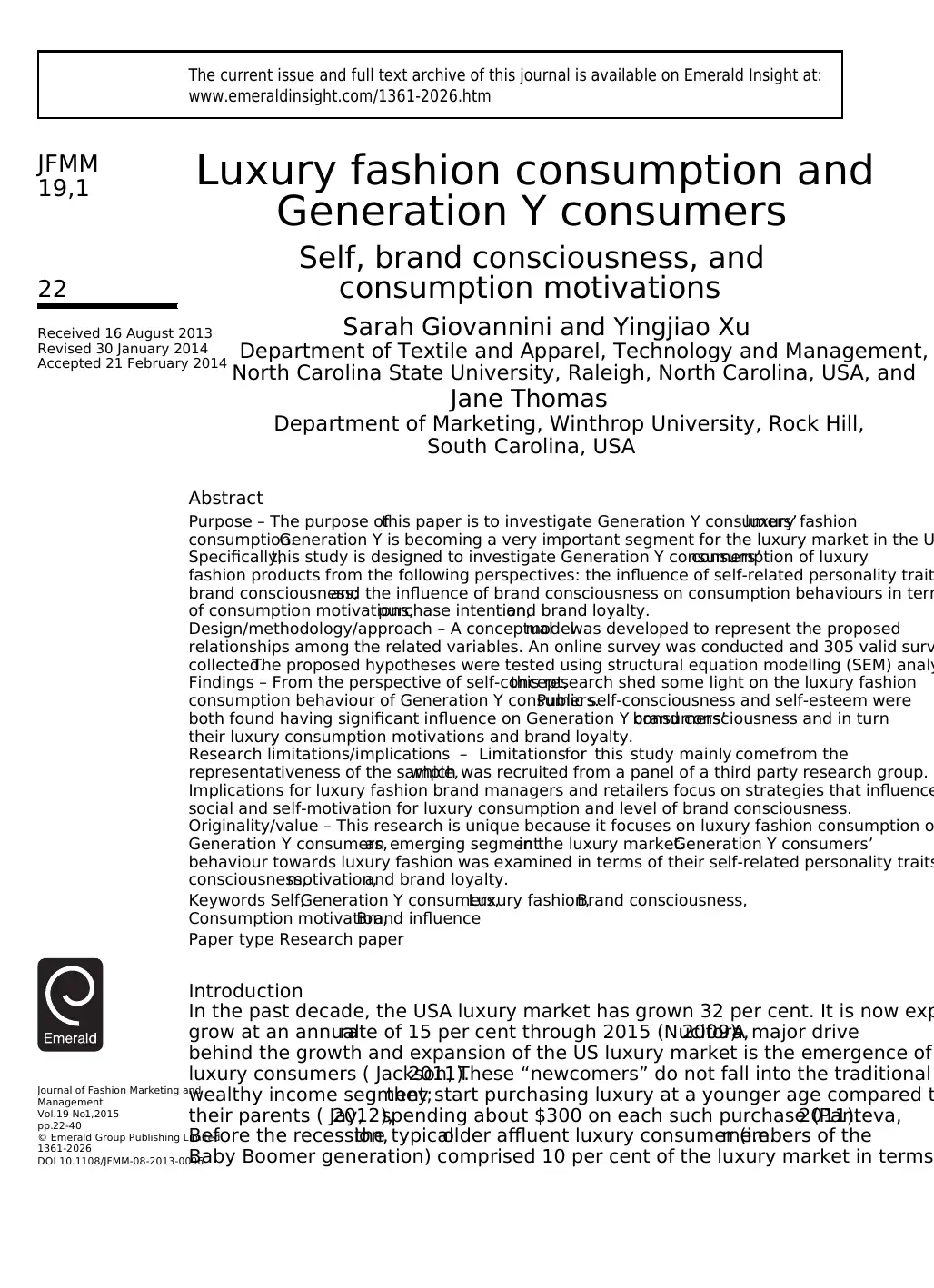
Luxury fashion consumption and
Generation Y consumers
Self, brand consciousness, and
consumption motivations
Sarah Giovannini and Yingjiao Xu
Department of Textile and Apparel, Technology and Management,
North Carolina State University, Raleigh, North Carolina, USA, and
Jane Thomas
Department of Marketing, Winthrop University, Rock Hill,
South Carolina, USA
Abstract
Purpose – The purpose ofthis paper is to investigate Generation Y consumers’luxury fashion
consumption.Generation Y is becoming a very important segment for the luxury market in the U
Specifically,this study is designed to investigate Generation Y consumers’consumption of luxury
fashion products from the following perspectives: the influence of self-related personality trait
brand consciousness;and the influence of brand consciousness on consumption behaviours in term
of consumption motivations,purchase intention,and brand loyalty.
Design/methodology/approach – A conceptualmodelwas developed to represent the proposed
relationships among the related variables. An online survey was conducted and 305 valid surv
collected.The proposed hypotheses were tested using structural equation modelling (SEM) analy
Findings – From the perspective of self-concept,this research shed some light on the luxury fashion
consumption behaviour of Generation Y consumers.Public self-consciousness and self-esteem were
both found having significant influence on Generation Y consumers’brand consciousness and in turn
their luxury consumption motivations and brand loyalty.
Research limitations/implications – Limitationsfor this study mainly comefrom the
representativeness of the sample,which was recruited from a panel of a third party research group.
Implications for luxury fashion brand managers and retailers focus on strategies that influence
social and self-motivation for luxury consumption and level of brand consciousness.
Originality/value – This research is unique because it focuses on luxury fashion consumption o
Generation Y consumers,an emerging segmentin the luxury market.Generation Y consumers’
behaviour towards luxury fashion was examined in terms of their self-related personality traits
consciousness,motivation,and brand loyalty.
Keywords Self,Generation Y consumers,Luxury fashion,Brand consciousness,
Consumption motivation,Brand influence
Paper type Research paper
Introduction
In the past decade, the USA luxury market has grown 32 per cent. It is now exp
grow at an annualrate of 15 per cent through 2015 (Nucifora,2009).A major drive
behind the growth and expansion of the US luxury market is the emergence of
luxury consumers ( Jackson,2011).These “newcomers” do not fall into the traditional
wealthy income segment;they start purchasing luxury at a younger age compared t
their parents ( Jay,2012),spending about $300 on each such purchase (Panteva,2011).
Before the recession,the typicalolder affluent luxury consumer (i.e.members of the
Baby Boomer generation) comprised 10 per cent of the luxury market in terms
Journal of Fashion Marketing and
Management
Vol.19 No.1,2015
pp.22-40
© Emerald Group Publishing Limited
1361-2026
DOI 10.1108/JFMM-08-2013-0096
Received 16 August 2013
Revised 30 January 2014
Accepted 21 February 2014
The current issue and full text archive of this journal is available on Emerald Insight at:
www.emeraldinsight.com/1361-2026.htm
22
JFMM
19,1
Generation Y consumers
Self, brand consciousness, and
consumption motivations
Sarah Giovannini and Yingjiao Xu
Department of Textile and Apparel, Technology and Management,
North Carolina State University, Raleigh, North Carolina, USA, and
Jane Thomas
Department of Marketing, Winthrop University, Rock Hill,
South Carolina, USA
Abstract
Purpose – The purpose ofthis paper is to investigate Generation Y consumers’luxury fashion
consumption.Generation Y is becoming a very important segment for the luxury market in the U
Specifically,this study is designed to investigate Generation Y consumers’consumption of luxury
fashion products from the following perspectives: the influence of self-related personality trait
brand consciousness;and the influence of brand consciousness on consumption behaviours in term
of consumption motivations,purchase intention,and brand loyalty.
Design/methodology/approach – A conceptualmodelwas developed to represent the proposed
relationships among the related variables. An online survey was conducted and 305 valid surv
collected.The proposed hypotheses were tested using structural equation modelling (SEM) analy
Findings – From the perspective of self-concept,this research shed some light on the luxury fashion
consumption behaviour of Generation Y consumers.Public self-consciousness and self-esteem were
both found having significant influence on Generation Y consumers’brand consciousness and in turn
their luxury consumption motivations and brand loyalty.
Research limitations/implications – Limitationsfor this study mainly comefrom the
representativeness of the sample,which was recruited from a panel of a third party research group.
Implications for luxury fashion brand managers and retailers focus on strategies that influence
social and self-motivation for luxury consumption and level of brand consciousness.
Originality/value – This research is unique because it focuses on luxury fashion consumption o
Generation Y consumers,an emerging segmentin the luxury market.Generation Y consumers’
behaviour towards luxury fashion was examined in terms of their self-related personality traits
consciousness,motivation,and brand loyalty.
Keywords Self,Generation Y consumers,Luxury fashion,Brand consciousness,
Consumption motivation,Brand influence
Paper type Research paper
Introduction
In the past decade, the USA luxury market has grown 32 per cent. It is now exp
grow at an annualrate of 15 per cent through 2015 (Nucifora,2009).A major drive
behind the growth and expansion of the US luxury market is the emergence of
luxury consumers ( Jackson,2011).These “newcomers” do not fall into the traditional
wealthy income segment;they start purchasing luxury at a younger age compared t
their parents ( Jay,2012),spending about $300 on each such purchase (Panteva,2011).
Before the recession,the typicalolder affluent luxury consumer (i.e.members of the
Baby Boomer generation) comprised 10 per cent of the luxury market in terms
Journal of Fashion Marketing and
Management
Vol.19 No.1,2015
pp.22-40
© Emerald Group Publishing Limited
1361-2026
DOI 10.1108/JFMM-08-2013-0096
Received 16 August 2013
Revised 30 January 2014
Accepted 21 February 2014
The current issue and full text archive of this journal is available on Emerald Insight at:
www.emeraldinsight.com/1361-2026.htm
22
JFMM
19,1
Paraphrase This Document
Need a fresh take? Get an instant paraphrase of this document with our AI Paraphraser
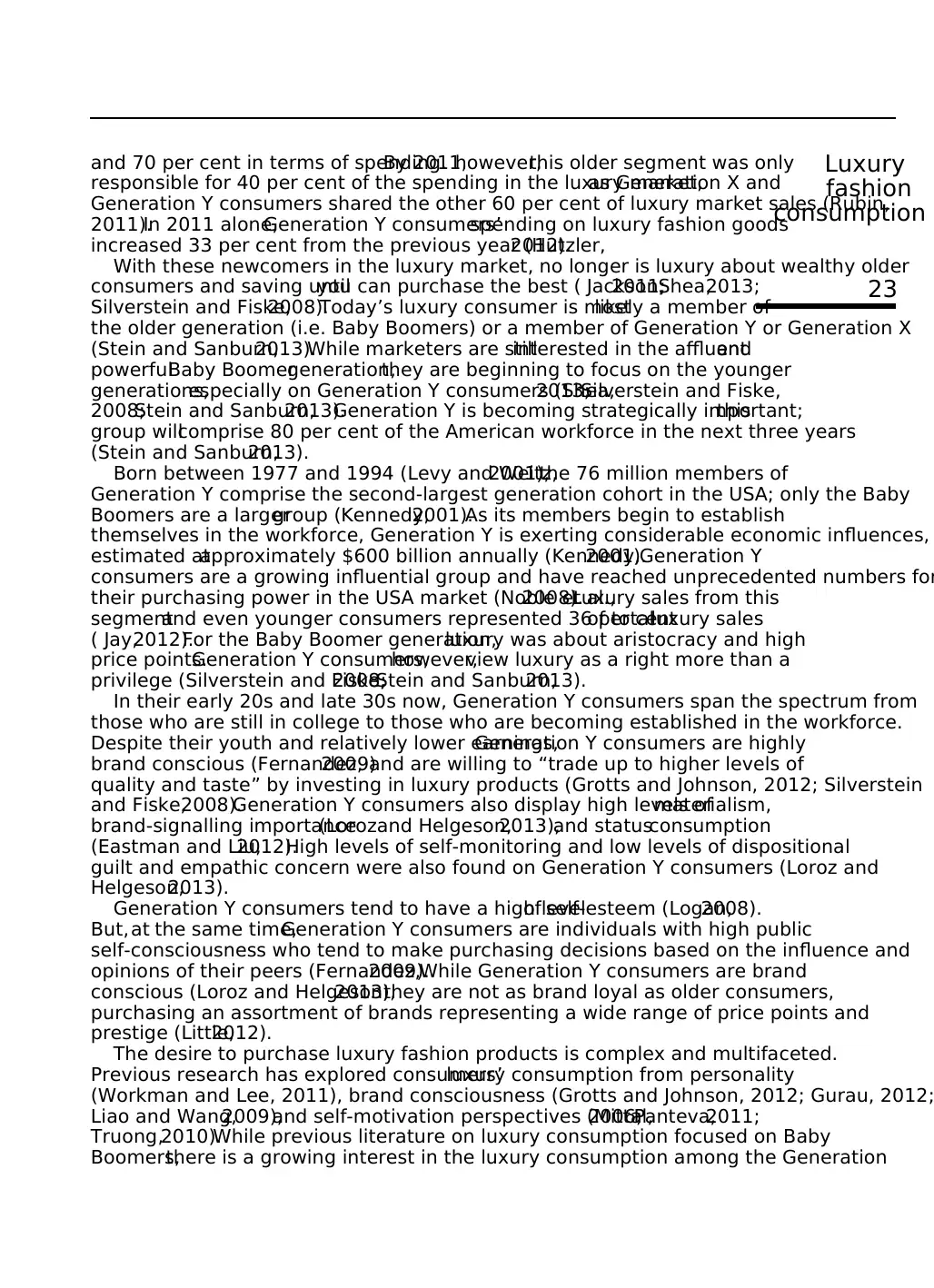
and 70 per cent in terms of spending.By 2011,however,this older segment was only
responsible for 40 per cent of the spending in the luxury market,as Generation X and
Generation Y consumers shared the other 60 per cent of luxury market sales (Rubin,
2011).In 2011 alone,Generation Y consumers’spending on luxury fashion goods
increased 33 per cent from the previous year (Hutzler,2012).
With these newcomers in the luxury market, no longer is luxury about wealthy older
consumers and saving untilyou can purchase the best ( Jackson,2011;Shea,2013;
Silverstein and Fiske,2008).Today’s luxury consumer is mostlikely a member of
the older generation (i.e. Baby Boomers) or a member of Generation Y or Generation X
(Stein and Sanburn,2013).While marketers are stillinterested in the affluentand
powerfulBaby Boomergeneration,they are beginning to focus on the younger
generations,especially on Generation Y consumers (Shea,2013;Silverstein and Fiske,
2008;Stein and Sanburn,2013).Generation Y is becoming strategically important;this
group willcomprise 80 per cent of the American workforce in the next three years
(Stein and Sanburn,2013).
Born between 1977 and 1994 (Levy and Weitz,2001),the 76 million members of
Generation Y comprise the second-largest generation cohort in the USA; only the Baby
Boomers are a largergroup (Kennedy,2001).As its members begin to establish
themselves in the workforce, Generation Y is exerting considerable economic influences,
estimated atapproximately $600 billion annually (Kennedy,2001).Generation Y
consumers are a growing influential group and have reached unprecedented numbers for
their purchasing power in the USA market (Noble et al.,2008).Luxury sales from this
segmentand even younger consumers represented 36 per centof totalluxury sales
( Jay,2012).For the Baby Boomer generation,luxury was about aristocracy and high
price points.Generation Y consumers,however,view luxury as a right more than a
privilege (Silverstein and Fiske,2008;Stein and Sanburn,2013).
In their early 20s and late 30s now, Generation Y consumers span the spectrum from
those who are still in college to those who are becoming established in the workforce.
Despite their youth and relatively lower earnings,Generation Y consumers are highly
brand conscious (Fernandez,2009)and are willing to “trade up to higher levels of
quality and taste” by investing in luxury products (Grotts and Johnson, 2012; Silverstein
and Fiske,2008).Generation Y consumers also display high levels ofmaterialism,
brand-signalling importance(Lorozand Helgeson,2013),and statusconsumption
(Eastman and Liu,2012).High levels of self-monitoring and low levels of dispositional
guilt and empathic concern were also found on Generation Y consumers (Loroz and
Helgeson,2013).
Generation Y consumers tend to have a high levelof self-esteem (Logan,2008).
But, at the same time,Generation Y consumers are individuals with high public
self-consciousness who tend to make purchasing decisions based on the influence and
opinions of their peers (Fernandez,2009).While Generation Y consumers are brand
conscious (Loroz and Helgeson,2013),they are not as brand loyal as older consumers,
purchasing an assortment of brands representing a wide range of price points and
prestige (Little,2012).
The desire to purchase luxury fashion products is complex and multifaceted.
Previous research has explored consumers’luxury consumption from personality
(Workman and Lee, 2011), brand consciousness (Grotts and Johnson, 2012; Gurau, 2012;
Liao and Wang,2009),and self-motivation perspectives (Mittal,2006;Panteva,2011;
Truong,2010).While previous literature on luxury consumption focused on Baby
Boomers,there is a growing interest in the luxury consumption among the Generation
23
Luxury
fashion
consumption
responsible for 40 per cent of the spending in the luxury market,as Generation X and
Generation Y consumers shared the other 60 per cent of luxury market sales (Rubin,
2011).In 2011 alone,Generation Y consumers’spending on luxury fashion goods
increased 33 per cent from the previous year (Hutzler,2012).
With these newcomers in the luxury market, no longer is luxury about wealthy older
consumers and saving untilyou can purchase the best ( Jackson,2011;Shea,2013;
Silverstein and Fiske,2008).Today’s luxury consumer is mostlikely a member of
the older generation (i.e. Baby Boomers) or a member of Generation Y or Generation X
(Stein and Sanburn,2013).While marketers are stillinterested in the affluentand
powerfulBaby Boomergeneration,they are beginning to focus on the younger
generations,especially on Generation Y consumers (Shea,2013;Silverstein and Fiske,
2008;Stein and Sanburn,2013).Generation Y is becoming strategically important;this
group willcomprise 80 per cent of the American workforce in the next three years
(Stein and Sanburn,2013).
Born between 1977 and 1994 (Levy and Weitz,2001),the 76 million members of
Generation Y comprise the second-largest generation cohort in the USA; only the Baby
Boomers are a largergroup (Kennedy,2001).As its members begin to establish
themselves in the workforce, Generation Y is exerting considerable economic influences,
estimated atapproximately $600 billion annually (Kennedy,2001).Generation Y
consumers are a growing influential group and have reached unprecedented numbers for
their purchasing power in the USA market (Noble et al.,2008).Luxury sales from this
segmentand even younger consumers represented 36 per centof totalluxury sales
( Jay,2012).For the Baby Boomer generation,luxury was about aristocracy and high
price points.Generation Y consumers,however,view luxury as a right more than a
privilege (Silverstein and Fiske,2008;Stein and Sanburn,2013).
In their early 20s and late 30s now, Generation Y consumers span the spectrum from
those who are still in college to those who are becoming established in the workforce.
Despite their youth and relatively lower earnings,Generation Y consumers are highly
brand conscious (Fernandez,2009)and are willing to “trade up to higher levels of
quality and taste” by investing in luxury products (Grotts and Johnson, 2012; Silverstein
and Fiske,2008).Generation Y consumers also display high levels ofmaterialism,
brand-signalling importance(Lorozand Helgeson,2013),and statusconsumption
(Eastman and Liu,2012).High levels of self-monitoring and low levels of dispositional
guilt and empathic concern were also found on Generation Y consumers (Loroz and
Helgeson,2013).
Generation Y consumers tend to have a high levelof self-esteem (Logan,2008).
But, at the same time,Generation Y consumers are individuals with high public
self-consciousness who tend to make purchasing decisions based on the influence and
opinions of their peers (Fernandez,2009).While Generation Y consumers are brand
conscious (Loroz and Helgeson,2013),they are not as brand loyal as older consumers,
purchasing an assortment of brands representing a wide range of price points and
prestige (Little,2012).
The desire to purchase luxury fashion products is complex and multifaceted.
Previous research has explored consumers’luxury consumption from personality
(Workman and Lee, 2011), brand consciousness (Grotts and Johnson, 2012; Gurau, 2012;
Liao and Wang,2009),and self-motivation perspectives (Mittal,2006;Panteva,2011;
Truong,2010).While previous literature on luxury consumption focused on Baby
Boomers,there is a growing interest in the luxury consumption among the Generation
23
Luxury
fashion
consumption
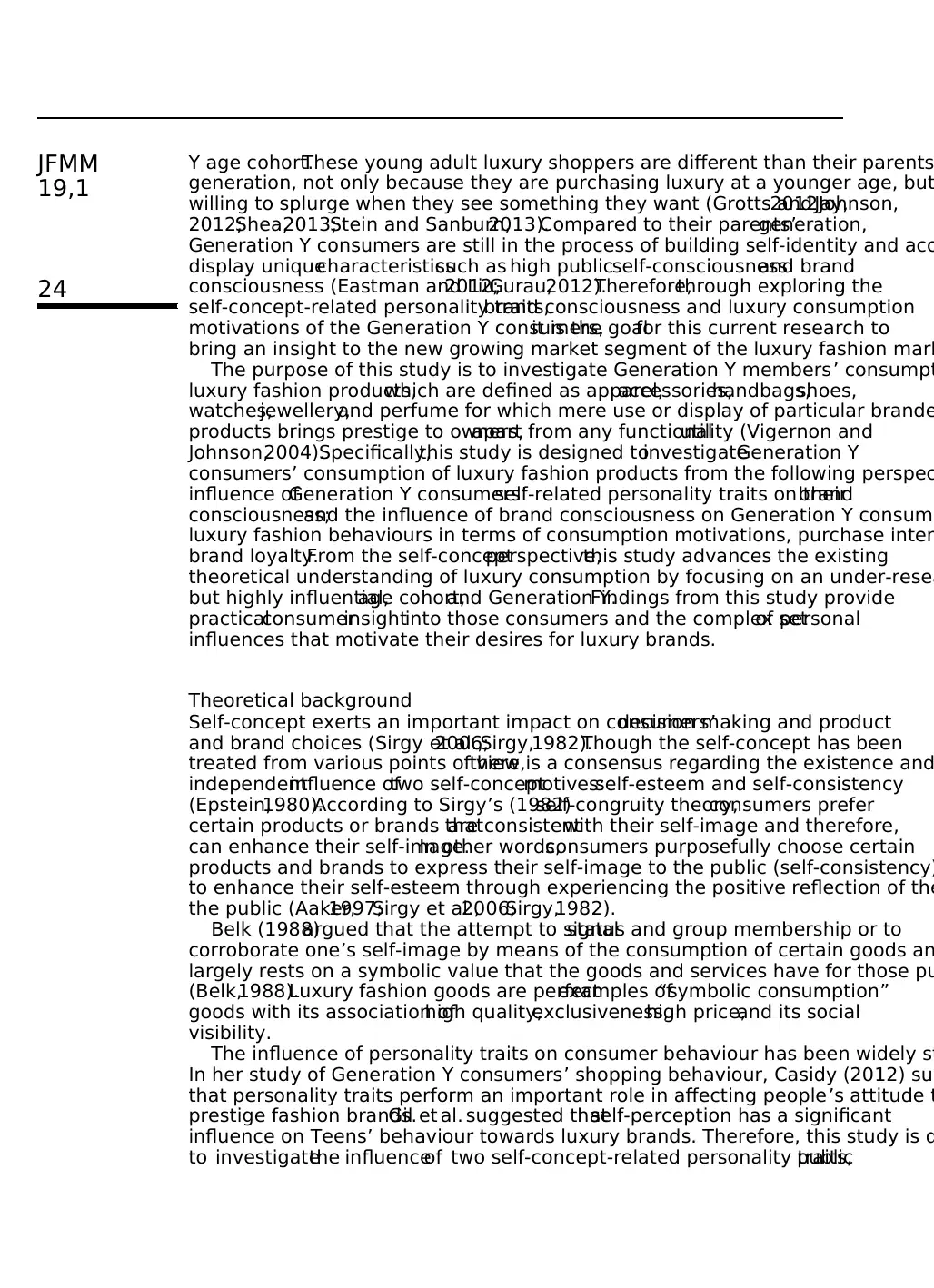
Y age cohort.These young adult luxury shoppers are different than their parents
generation, not only because they are purchasing luxury at a younger age, but
willing to splurge when they see something they want (Grotts and Johnson,2012;Jay,
2012;Shea,2013;Stein and Sanburn,2013).Compared to their parents’generation,
Generation Y consumers are still in the process of building self-identity and acc
display uniquecharacteristicssuch as high publicself-consciousnessand brand
consciousness (Eastman and Liu,2012;Gurau,2012).Therefore,through exploring the
self-concept-related personality traits,brand consciousness and luxury consumption
motivations of the Generation Y consumers,it is the goalfor this current research to
bring an insight to the new growing market segment of the luxury fashion mark
The purpose of this study is to investigate Generation Y members’ consumpt
luxury fashion products,which are defined as apparel,accessories,handbags,shoes,
watches,jewellery,and perfume for which mere use or display of particular brande
products brings prestige to owners,apart from any functionalutility (Vigernon and
Johnson,2004).Specifically,this study is designed toinvestigateGeneration Y
consumers’ consumption of luxury fashion products from the following perspec
influence ofGeneration Y consumers’self-related personality traits on theirbrand
consciousness;and the influence of brand consciousness on Generation Y consume
luxury fashion behaviours in terms of consumption motivations, purchase inten
brand loyalty.From the self-conceptperspective,this study advances the existing
theoretical understanding of luxury consumption by focusing on an under-resea
but highly influential,age cohort,and Generation Y.Findings from this study provide
practicalconsumerinsightinto those consumers and the complex setof personal
influences that motivate their desires for luxury brands.
Theoretical background
Self-concept exerts an important impact on consumers’decision making and product
and brand choices (Sirgy et al.,2006;Sirgy,1982).Though the self-concept has been
treated from various points of view,there is a consensus regarding the existence and
independentinfluence oftwo self-conceptmotives:self-esteem and self-consistency
(Epstein,1980).According to Sirgy’s (1982)self-congruity theory,consumers prefer
certain products or brands thatare consistentwith their self-image and therefore,
can enhance their self-image.In other words,consumers purposefully choose certain
products and brands to express their self-image to the public (self-consistency)
to enhance their self-esteem through experiencing the positive reflection of the
the public (Aaker,1997;Sirgy et al.,2006;Sirgy,1982).
Belk (1988)argued that the attempt to signalstatus and group membership or to
corroborate one’s self-image by means of the consumption of certain goods an
largely rests on a symbolic value that the goods and services have for those pu
(Belk,1988).Luxury fashion goods are perfectexamples of“symbolic consumption”
goods with its association ofhigh quality,exclusiveness,high price,and its social
visibility.
The influence of personality traits on consumer behaviour has been widely st
In her study of Generation Y consumers’ shopping behaviour, Casidy (2012) sug
that personality traits perform an important role in affecting people’s attitude t
prestige fashion brands.Gil et al. suggested thatself-perception has a significant
influence on Teens’ behaviour towards luxury brands. Therefore, this study is d
to investigatethe influenceof two self-concept-related personality traits,public
24
JFMM
19,1
generation, not only because they are purchasing luxury at a younger age, but
willing to splurge when they see something they want (Grotts and Johnson,2012;Jay,
2012;Shea,2013;Stein and Sanburn,2013).Compared to their parents’generation,
Generation Y consumers are still in the process of building self-identity and acc
display uniquecharacteristicssuch as high publicself-consciousnessand brand
consciousness (Eastman and Liu,2012;Gurau,2012).Therefore,through exploring the
self-concept-related personality traits,brand consciousness and luxury consumption
motivations of the Generation Y consumers,it is the goalfor this current research to
bring an insight to the new growing market segment of the luxury fashion mark
The purpose of this study is to investigate Generation Y members’ consumpt
luxury fashion products,which are defined as apparel,accessories,handbags,shoes,
watches,jewellery,and perfume for which mere use or display of particular brande
products brings prestige to owners,apart from any functionalutility (Vigernon and
Johnson,2004).Specifically,this study is designed toinvestigateGeneration Y
consumers’ consumption of luxury fashion products from the following perspec
influence ofGeneration Y consumers’self-related personality traits on theirbrand
consciousness;and the influence of brand consciousness on Generation Y consume
luxury fashion behaviours in terms of consumption motivations, purchase inten
brand loyalty.From the self-conceptperspective,this study advances the existing
theoretical understanding of luxury consumption by focusing on an under-resea
but highly influential,age cohort,and Generation Y.Findings from this study provide
practicalconsumerinsightinto those consumers and the complex setof personal
influences that motivate their desires for luxury brands.
Theoretical background
Self-concept exerts an important impact on consumers’decision making and product
and brand choices (Sirgy et al.,2006;Sirgy,1982).Though the self-concept has been
treated from various points of view,there is a consensus regarding the existence and
independentinfluence oftwo self-conceptmotives:self-esteem and self-consistency
(Epstein,1980).According to Sirgy’s (1982)self-congruity theory,consumers prefer
certain products or brands thatare consistentwith their self-image and therefore,
can enhance their self-image.In other words,consumers purposefully choose certain
products and brands to express their self-image to the public (self-consistency)
to enhance their self-esteem through experiencing the positive reflection of the
the public (Aaker,1997;Sirgy et al.,2006;Sirgy,1982).
Belk (1988)argued that the attempt to signalstatus and group membership or to
corroborate one’s self-image by means of the consumption of certain goods an
largely rests on a symbolic value that the goods and services have for those pu
(Belk,1988).Luxury fashion goods are perfectexamples of“symbolic consumption”
goods with its association ofhigh quality,exclusiveness,high price,and its social
visibility.
The influence of personality traits on consumer behaviour has been widely st
In her study of Generation Y consumers’ shopping behaviour, Casidy (2012) sug
that personality traits perform an important role in affecting people’s attitude t
prestige fashion brands.Gil et al. suggested thatself-perception has a significant
influence on Teens’ behaviour towards luxury brands. Therefore, this study is d
to investigatethe influenceof two self-concept-related personality traits,public
24
JFMM
19,1
⊘ This is a preview!⊘
Do you want full access?
Subscribe today to unlock all pages.

Trusted by 1+ million students worldwide
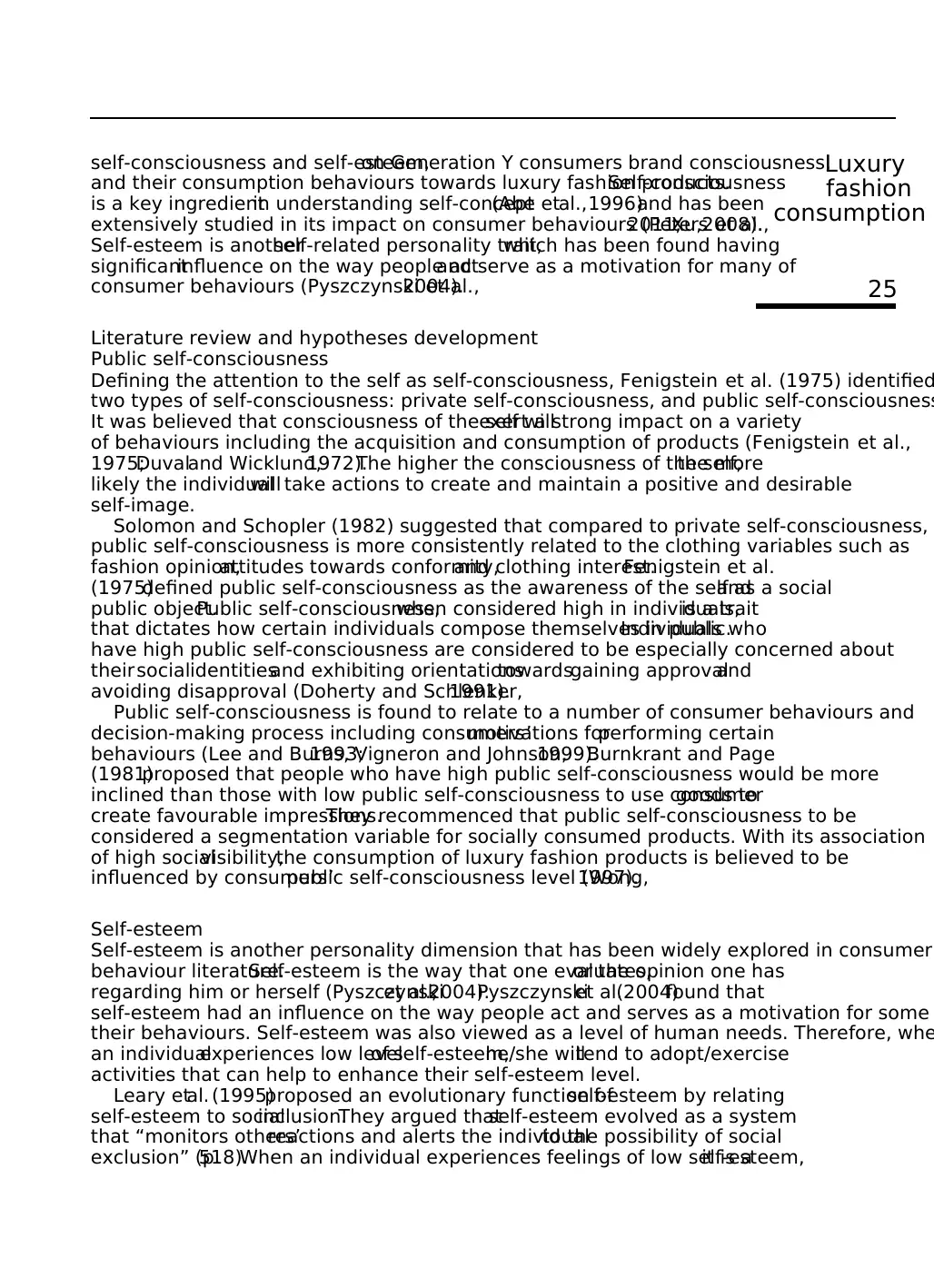
self-consciousness and self-esteem,on Generation Y consumers brand consciousness,
and their consumption behaviours towards luxury fashion products.Self-consciousness
is a key ingredientin understanding self-concept(Abe etal.,1996)and has been
extensively studied in its impact on consumer behaviours (Peters et al.,2011;Xu,2008).
Self-esteem is anotherself-related personality trait,which has been found having
significantinfluence on the way people actand serve as a motivation for many of
consumer behaviours (Pyszczynski et al.,2004).
Literature review and hypotheses development
Public self-consciousness
Defining the attention to the self as self-consciousness, Fenigstein et al. (1975) identified
two types of self-consciousness: private self-consciousness, and public self-consciousness
It was believed that consciousness of the self willexert a strong impact on a variety
of behaviours including the acquisition and consumption of products (Fenigstein et al.,
1975;Duvaland Wicklund,1972).The higher the consciousness of the self,the more
likely the individualwill take actions to create and maintain a positive and desirable
self-image.
Solomon and Schopler (1982) suggested that compared to private self-consciousness,
public self-consciousness is more consistently related to the clothing variables such as
fashion opinion,attitudes towards conformity,and clothing interest.Fenigstein et al.
(1975)defined public self-consciousness as the awareness of the self as a socialand
public object.Public self-consciousness,when considered high in individuals,is a trait
that dictates how certain individuals compose themselves in public.Individuals who
have high public self-consciousness are considered to be especially concerned about
theirsocialidentitiesand exhibiting orientationstowardsgaining approvaland
avoiding disapproval (Doherty and Schlenker,1991).
Public self-consciousness is found to relate to a number of consumer behaviours and
decision-making process including consumers’motivations forperforming certain
behaviours (Lee and Burns,1993;Vigneron and Johnson,1999).Burnkrant and Page
(1981)proposed that people who have high public self-consciousness would be more
inclined than those with low public self-consciousness to use consumergoods to
create favourable impressions.They recommenced that public self-consciousness to be
considered a segmentation variable for socially consumed products. With its association
of high socialvisibility,the consumption of luxury fashion products is believed to be
influenced by consumers’public self-consciousness level (Wong,1997).
Self-esteem
Self-esteem is another personality dimension that has been widely explored in consumer
behaviour literature.Self-esteem is the way that one evaluates,or the opinion one has
regarding him or herself (Pyszczynskiet al.,2004).Pyszczynskiet al.(2004)found that
self-esteem had an influence on the way people act and serves as a motivation for some
their behaviours. Self-esteem was also viewed as a level of human needs. Therefore, whe
an individualexperiences low levelof self-esteem,he/she willtend to adopt/exercise
activities that can help to enhance their self-esteem level.
Leary etal. (1995)proposed an evolutionary function ofself-esteem by relating
self-esteem to socialinclusion.They argued thatself-esteem evolved as a system
that “monitors others’reactions and alerts the individualto the possibility of social
exclusion” (p.518).When an individual experiences feelings of low self-esteem,it is a
25
Luxury
fashion
consumption
and their consumption behaviours towards luxury fashion products.Self-consciousness
is a key ingredientin understanding self-concept(Abe etal.,1996)and has been
extensively studied in its impact on consumer behaviours (Peters et al.,2011;Xu,2008).
Self-esteem is anotherself-related personality trait,which has been found having
significantinfluence on the way people actand serve as a motivation for many of
consumer behaviours (Pyszczynski et al.,2004).
Literature review and hypotheses development
Public self-consciousness
Defining the attention to the self as self-consciousness, Fenigstein et al. (1975) identified
two types of self-consciousness: private self-consciousness, and public self-consciousness
It was believed that consciousness of the self willexert a strong impact on a variety
of behaviours including the acquisition and consumption of products (Fenigstein et al.,
1975;Duvaland Wicklund,1972).The higher the consciousness of the self,the more
likely the individualwill take actions to create and maintain a positive and desirable
self-image.
Solomon and Schopler (1982) suggested that compared to private self-consciousness,
public self-consciousness is more consistently related to the clothing variables such as
fashion opinion,attitudes towards conformity,and clothing interest.Fenigstein et al.
(1975)defined public self-consciousness as the awareness of the self as a socialand
public object.Public self-consciousness,when considered high in individuals,is a trait
that dictates how certain individuals compose themselves in public.Individuals who
have high public self-consciousness are considered to be especially concerned about
theirsocialidentitiesand exhibiting orientationstowardsgaining approvaland
avoiding disapproval (Doherty and Schlenker,1991).
Public self-consciousness is found to relate to a number of consumer behaviours and
decision-making process including consumers’motivations forperforming certain
behaviours (Lee and Burns,1993;Vigneron and Johnson,1999).Burnkrant and Page
(1981)proposed that people who have high public self-consciousness would be more
inclined than those with low public self-consciousness to use consumergoods to
create favourable impressions.They recommenced that public self-consciousness to be
considered a segmentation variable for socially consumed products. With its association
of high socialvisibility,the consumption of luxury fashion products is believed to be
influenced by consumers’public self-consciousness level (Wong,1997).
Self-esteem
Self-esteem is another personality dimension that has been widely explored in consumer
behaviour literature.Self-esteem is the way that one evaluates,or the opinion one has
regarding him or herself (Pyszczynskiet al.,2004).Pyszczynskiet al.(2004)found that
self-esteem had an influence on the way people act and serves as a motivation for some
their behaviours. Self-esteem was also viewed as a level of human needs. Therefore, whe
an individualexperiences low levelof self-esteem,he/she willtend to adopt/exercise
activities that can help to enhance their self-esteem level.
Leary etal. (1995)proposed an evolutionary function ofself-esteem by relating
self-esteem to socialinclusion.They argued thatself-esteem evolved as a system
that “monitors others’reactions and alerts the individualto the possibility of social
exclusion” (p.518).When an individual experiences feelings of low self-esteem,it is a
25
Luxury
fashion
consumption
Paraphrase This Document
Need a fresh take? Get an instant paraphrase of this document with our AI Paraphraser
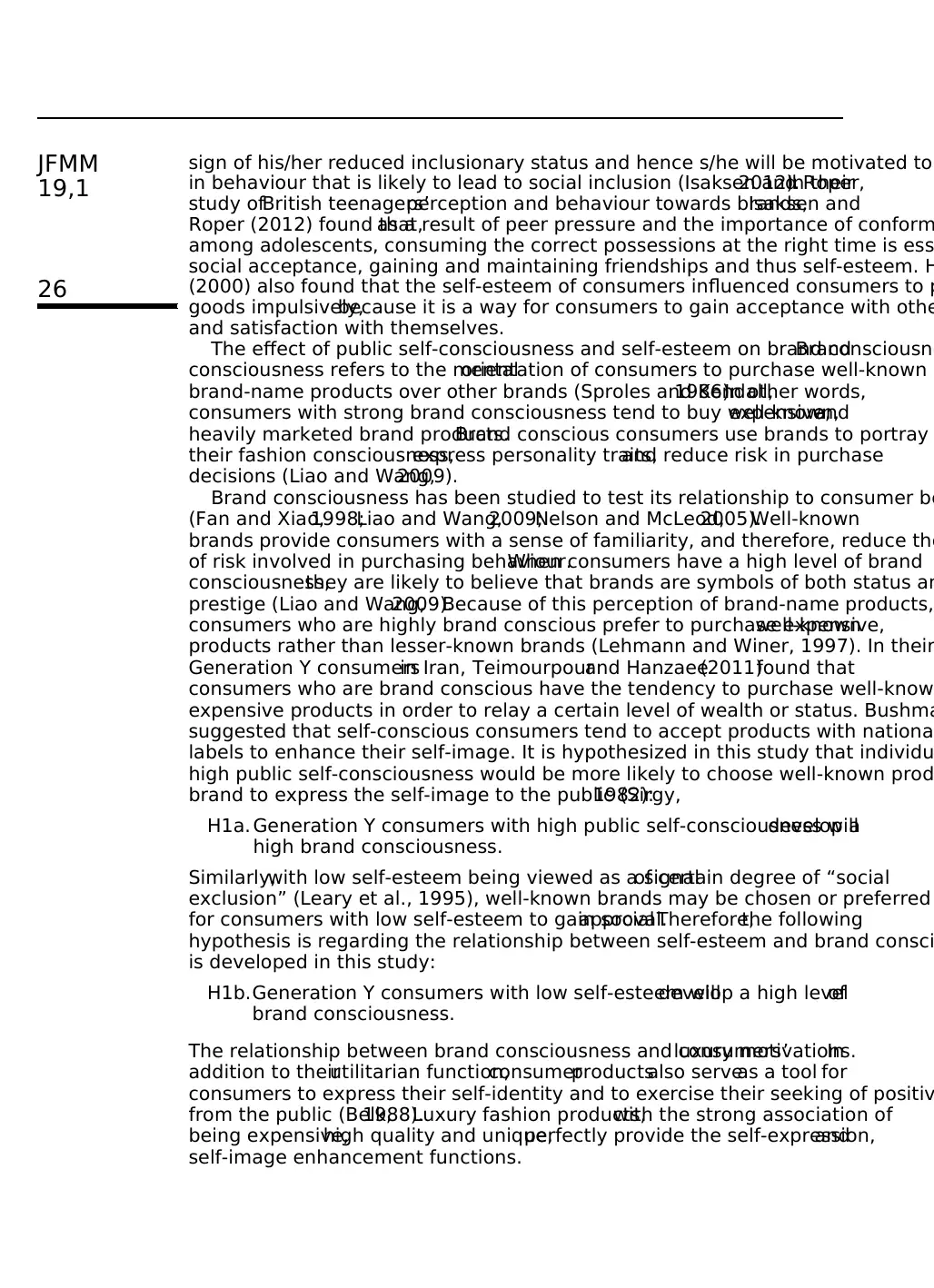
sign of his/her reduced inclusionary status and hence s/he will be motivated to
in behaviour that is likely to lead to social inclusion (Isaksen and Roper,2012).In their
study ofBritish teenagers’perception and behaviour towards brands,Isaksen and
Roper (2012) found that,as a result of peer pressure and the importance of conform
among adolescents, consuming the correct possessions at the right time is ess
social acceptance, gaining and maintaining friendships and thus self-esteem. H
(2000) also found that the self-esteem of consumers influenced consumers to p
goods impulsively,because it is a way for consumers to gain acceptance with othe
and satisfaction with themselves.
The effect of public self-consciousness and self-esteem on brand consciousneBrand
consciousness refers to the mentalorientation of consumers to purchase well-known
brand-name products over other brands (Sproles and Kendall,1986).In other words,
consumers with strong brand consciousness tend to buy well-known,expensive,and
heavily marketed brand products.Brand conscious consumers use brands to portray
their fashion consciousness,express personality traits,and reduce risk in purchase
decisions (Liao and Wang,2009).
Brand consciousness has been studied to test its relationship to consumer be
(Fan and Xiao,1998;Liao and Wang,2009;Nelson and McLeod,2005).Well-known
brands provide consumers with a sense of familiarity, and therefore, reduce the
of risk involved in purchasing behaviour.When consumers have a high level of brand
consciousness,they are likely to believe that brands are symbols of both status an
prestige (Liao and Wang,2009).Because of this perception of brand-name products,
consumers who are highly brand conscious prefer to purchase expensive,well-known
products rather than lesser-known brands (Lehmann and Winer, 1997). In their
Generation Y consumersin Iran, Teimourpourand Hanzaee(2011)found that
consumers who are brand conscious have the tendency to purchase well-know
expensive products in order to relay a certain level of wealth or status. Bushma
suggested that self-conscious consumers tend to accept products with nationa
labels to enhance their self-image. It is hypothesized in this study that individu
high public self-consciousness would be more likely to choose well-known prod
brand to express the self-image to the public (Sirgy,1982):
H1a. Generation Y consumers with high public self-consciousness willdevelop a
high brand consciousness.
Similarly,with low self-esteem being viewed as a signalof certain degree of “social
exclusion” (Leary et al., 1995), well-known brands may be chosen or preferred
for consumers with low self-esteem to gain socialapproval.Therefore,the following
hypothesis is regarding the relationship between self-esteem and brand consci
is developed in this study:
H1b.Generation Y consumers with low self-esteem willdevelop a high levelof
brand consciousness.
The relationship between brand consciousness and consumers’luxury motivations.In
addition to theirutilitarian function,consumerproductsalso serveas a tool for
consumers to express their self-identity and to exercise their seeking of positiv
from the public (Belk,1988).Luxury fashion products,with the strong association of
being expensive,high quality and unique,perfectly provide the self-expression,and
self-image enhancement functions.
26
JFMM
19,1
in behaviour that is likely to lead to social inclusion (Isaksen and Roper,2012).In their
study ofBritish teenagers’perception and behaviour towards brands,Isaksen and
Roper (2012) found that,as a result of peer pressure and the importance of conform
among adolescents, consuming the correct possessions at the right time is ess
social acceptance, gaining and maintaining friendships and thus self-esteem. H
(2000) also found that the self-esteem of consumers influenced consumers to p
goods impulsively,because it is a way for consumers to gain acceptance with othe
and satisfaction with themselves.
The effect of public self-consciousness and self-esteem on brand consciousneBrand
consciousness refers to the mentalorientation of consumers to purchase well-known
brand-name products over other brands (Sproles and Kendall,1986).In other words,
consumers with strong brand consciousness tend to buy well-known,expensive,and
heavily marketed brand products.Brand conscious consumers use brands to portray
their fashion consciousness,express personality traits,and reduce risk in purchase
decisions (Liao and Wang,2009).
Brand consciousness has been studied to test its relationship to consumer be
(Fan and Xiao,1998;Liao and Wang,2009;Nelson and McLeod,2005).Well-known
brands provide consumers with a sense of familiarity, and therefore, reduce the
of risk involved in purchasing behaviour.When consumers have a high level of brand
consciousness,they are likely to believe that brands are symbols of both status an
prestige (Liao and Wang,2009).Because of this perception of brand-name products,
consumers who are highly brand conscious prefer to purchase expensive,well-known
products rather than lesser-known brands (Lehmann and Winer, 1997). In their
Generation Y consumersin Iran, Teimourpourand Hanzaee(2011)found that
consumers who are brand conscious have the tendency to purchase well-know
expensive products in order to relay a certain level of wealth or status. Bushma
suggested that self-conscious consumers tend to accept products with nationa
labels to enhance their self-image. It is hypothesized in this study that individu
high public self-consciousness would be more likely to choose well-known prod
brand to express the self-image to the public (Sirgy,1982):
H1a. Generation Y consumers with high public self-consciousness willdevelop a
high brand consciousness.
Similarly,with low self-esteem being viewed as a signalof certain degree of “social
exclusion” (Leary et al., 1995), well-known brands may be chosen or preferred
for consumers with low self-esteem to gain socialapproval.Therefore,the following
hypothesis is regarding the relationship between self-esteem and brand consci
is developed in this study:
H1b.Generation Y consumers with low self-esteem willdevelop a high levelof
brand consciousness.
The relationship between brand consciousness and consumers’luxury motivations.In
addition to theirutilitarian function,consumerproductsalso serveas a tool for
consumers to express their self-identity and to exercise their seeking of positiv
from the public (Belk,1988).Luxury fashion products,with the strong association of
being expensive,high quality and unique,perfectly provide the self-expression,and
self-image enhancement functions.
26
JFMM
19,1
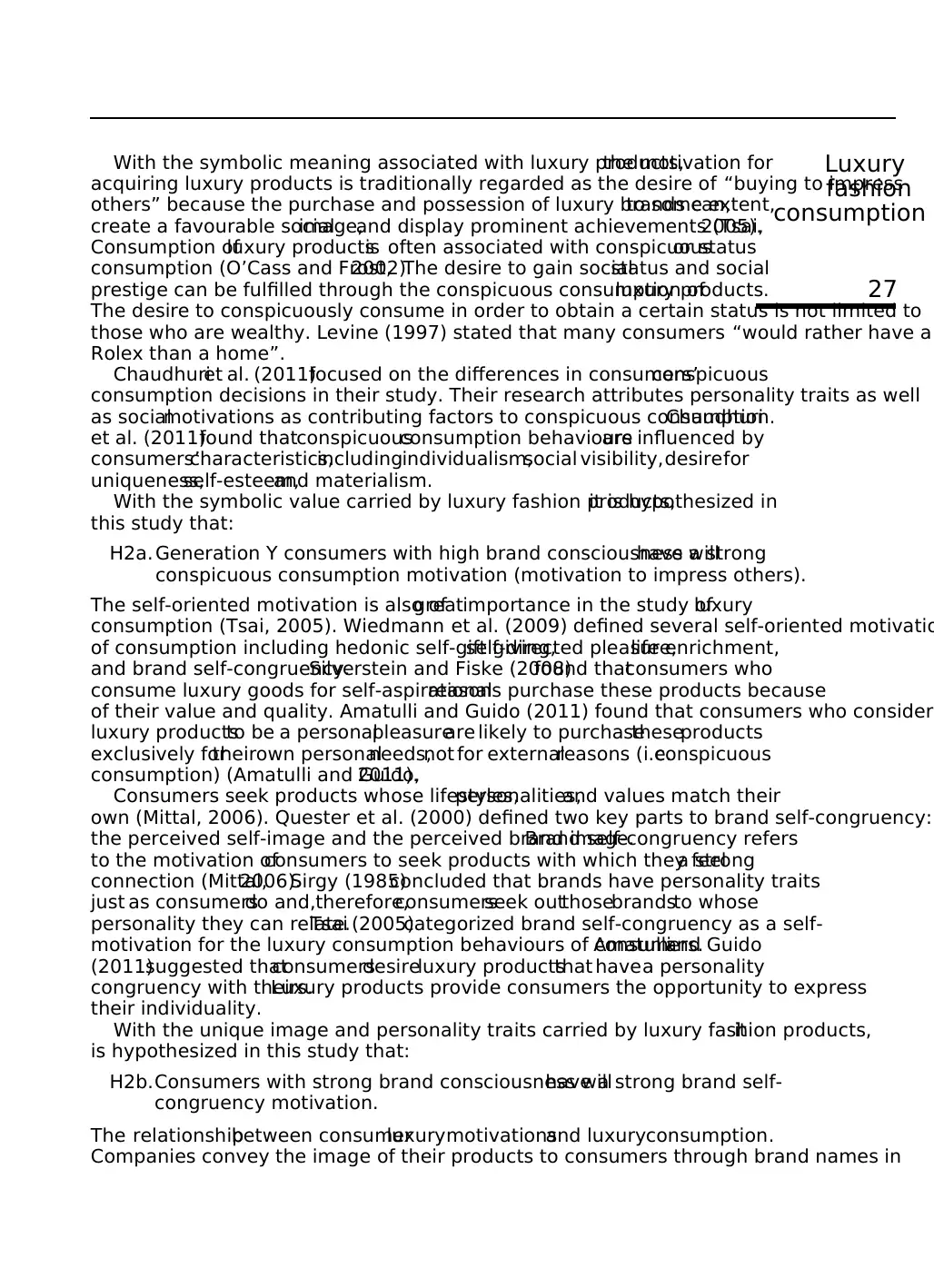
With the symbolic meaning associated with luxury products,the motivation for
acquiring luxury products is traditionally regarded as the desire of “buying to impress
others” because the purchase and possession of luxury brands can,to some extent,
create a favourable socialimage,and display prominent achievements (Tsai,2005).
Consumption ofluxury productsis often associated with conspicuousor status
consumption (O’Cass and Frost,2002).The desire to gain socialstatus and social
prestige can be fulfilled through the conspicuous consumption ofluxury products.
The desire to conspicuously consume in order to obtain a certain status is not limited to
those who are wealthy. Levine (1997) stated that many consumers “would rather have a
Rolex than a home”.
Chaudhuriet al. (2011)focused on the differences in consumers’conspicuous
consumption decisions in their study. Their research attributes personality traits as well
as socialmotivations as contributing factors to conspicuous consumption.Chaudhuri
et al. (2011)found thatconspicuousconsumption behavioursare influenced by
consumers’characteristics,includingindividualism,social visibility,desirefor
uniqueness,self-esteem,and materialism.
With the symbolic value carried by luxury fashion products,it is hypothesized in
this study that:
H2a. Generation Y consumers with high brand consciousness willhave a strong
conspicuous consumption motivation (motivation to impress others).
The self-oriented motivation is also ofgreatimportance in the study ofluxury
consumption (Tsai, 2005). Wiedmann et al. (2009) defined several self-oriented motivatio
of consumption including hedonic self-gift giving,self-directed pleasure,life enrichment,
and brand self-congruency.Silverstein and Fiske (2008)found thatconsumers who
consume luxury goods for self-aspirationalreasons purchase these products because
of their value and quality. Amatulli and Guido (2011) found that consumers who consider
luxury productsto be a personalpleasureare likely to purchasetheseproducts
exclusively fortheirown personalneeds,not for externalreasons (i.e.conspicuous
consumption) (Amatulli and Guido,2011).
Consumers seek products whose lifestyles,personalities,and values match their
own (Mittal, 2006). Quester et al. (2000) defined two key parts to brand self-congruency:
the perceived self-image and the perceived brand image.Brand self-congruency refers
to the motivation ofconsumers to seek products with which they feela strong
connection (Mittal,2006).Sirgy (1985)concluded that brands have personality traits
just as consumersdo and,therefore,consumersseek outthosebrandsto whose
personality they can relate.Tsai (2005)categorized brand self-congruency as a self-
motivation for the luxury consumption behaviours of consumers.Amatulliand Guido
(2011)suggested thatconsumersdesireluxury productsthat havea personality
congruency with theirs.Luxury products provide consumers the opportunity to express
their individuality.
With the unique image and personality traits carried by luxury fashion products,it
is hypothesized in this study that:
H2b.Consumers with strong brand consciousness willhave a strong brand self-
congruency motivation.
The relationshipbetween consumerluxurymotivationsand luxuryconsumption.
Companies convey the image of their products to consumers through brand names in
27
Luxury
fashion
consumption
acquiring luxury products is traditionally regarded as the desire of “buying to impress
others” because the purchase and possession of luxury brands can,to some extent,
create a favourable socialimage,and display prominent achievements (Tsai,2005).
Consumption ofluxury productsis often associated with conspicuousor status
consumption (O’Cass and Frost,2002).The desire to gain socialstatus and social
prestige can be fulfilled through the conspicuous consumption ofluxury products.
The desire to conspicuously consume in order to obtain a certain status is not limited to
those who are wealthy. Levine (1997) stated that many consumers “would rather have a
Rolex than a home”.
Chaudhuriet al. (2011)focused on the differences in consumers’conspicuous
consumption decisions in their study. Their research attributes personality traits as well
as socialmotivations as contributing factors to conspicuous consumption.Chaudhuri
et al. (2011)found thatconspicuousconsumption behavioursare influenced by
consumers’characteristics,includingindividualism,social visibility,desirefor
uniqueness,self-esteem,and materialism.
With the symbolic value carried by luxury fashion products,it is hypothesized in
this study that:
H2a. Generation Y consumers with high brand consciousness willhave a strong
conspicuous consumption motivation (motivation to impress others).
The self-oriented motivation is also ofgreatimportance in the study ofluxury
consumption (Tsai, 2005). Wiedmann et al. (2009) defined several self-oriented motivatio
of consumption including hedonic self-gift giving,self-directed pleasure,life enrichment,
and brand self-congruency.Silverstein and Fiske (2008)found thatconsumers who
consume luxury goods for self-aspirationalreasons purchase these products because
of their value and quality. Amatulli and Guido (2011) found that consumers who consider
luxury productsto be a personalpleasureare likely to purchasetheseproducts
exclusively fortheirown personalneeds,not for externalreasons (i.e.conspicuous
consumption) (Amatulli and Guido,2011).
Consumers seek products whose lifestyles,personalities,and values match their
own (Mittal, 2006). Quester et al. (2000) defined two key parts to brand self-congruency:
the perceived self-image and the perceived brand image.Brand self-congruency refers
to the motivation ofconsumers to seek products with which they feela strong
connection (Mittal,2006).Sirgy (1985)concluded that brands have personality traits
just as consumersdo and,therefore,consumersseek outthosebrandsto whose
personality they can relate.Tsai (2005)categorized brand self-congruency as a self-
motivation for the luxury consumption behaviours of consumers.Amatulliand Guido
(2011)suggested thatconsumersdesireluxury productsthat havea personality
congruency with theirs.Luxury products provide consumers the opportunity to express
their individuality.
With the unique image and personality traits carried by luxury fashion products,it
is hypothesized in this study that:
H2b.Consumers with strong brand consciousness willhave a strong brand self-
congruency motivation.
The relationshipbetween consumerluxurymotivationsand luxuryconsumption.
Companies convey the image of their products to consumers through brand names in
27
Luxury
fashion
consumption
⊘ This is a preview!⊘
Do you want full access?
Subscribe today to unlock all pages.

Trusted by 1+ million students worldwide
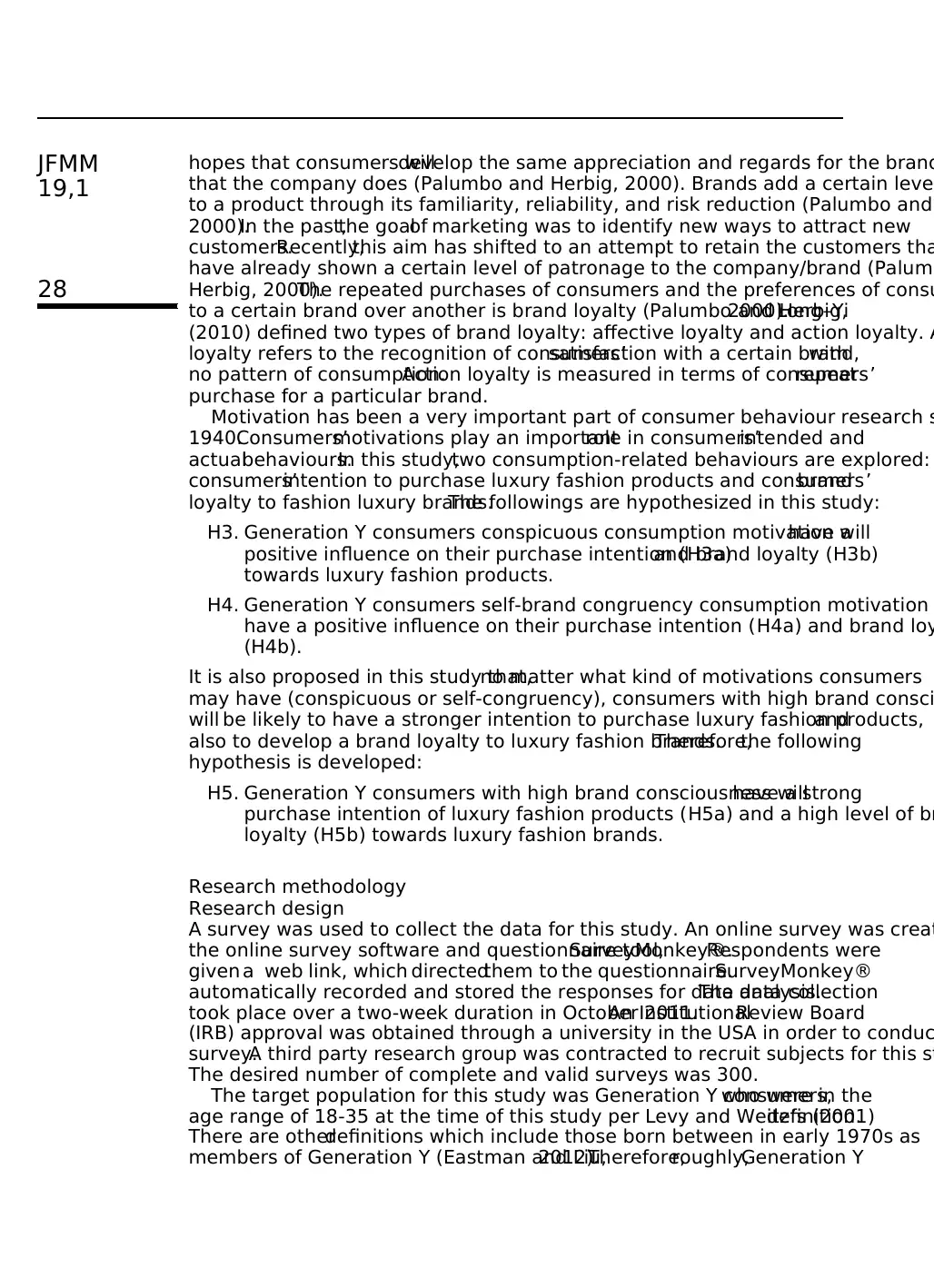
hopes that consumers willdevelop the same appreciation and regards for the brand
that the company does (Palumbo and Herbig, 2000). Brands add a certain level
to a product through its familiarity, reliability, and risk reduction (Palumbo and
2000).In the past,the goalof marketing was to identify new ways to attract new
customers.Recently,this aim has shifted to an attempt to retain the customers tha
have already shown a certain level of patronage to the company/brand (Palumb
Herbig, 2000).The repeated purchases of consumers and the preferences of consu
to a certain brand over another is brand loyalty (Palumbo and Herbig,2000).Long–Yi
(2010) defined two types of brand loyalty: affective loyalty and action loyalty. A
loyalty refers to the recognition of consumers’satisfaction with a certain brand,with
no pattern of consumption.Action loyalty is measured in terms of consumers’repeat
purchase for a particular brand.
Motivation has been a very important part of consumer behaviour research s
1940.Consumers’motivations play an importantrole in consumers’intended and
actualbehaviours.In this study,two consumption-related behaviours are explored:
consumers’intention to purchase luxury fashion products and consumers’brand
loyalty to fashion luxury brands.The followings are hypothesized in this study:
H3. Generation Y consumers conspicuous consumption motivation willhave a
positive influence on their purchase intention (H3a)and brand loyalty (H3b)
towards luxury fashion products.
H4. Generation Y consumers self-brand congruency consumption motivation
have a positive influence on their purchase intention (H4a) and brand loy
(H4b).
It is also proposed in this study that,no matter what kind of motivations consumers
may have (conspicuous or self-congruency), consumers with high brand consci
will be likely to have a stronger intention to purchase luxury fashion products,and
also to develop a brand loyalty to luxury fashion brands.Therefore,the following
hypothesis is developed:
H5. Generation Y consumers with high brand consciousness willhave a strong
purchase intention of luxury fashion products (H5a) and a high level of br
loyalty (H5b) towards luxury fashion brands.
Research methodology
Research design
A survey was used to collect the data for this study. An online survey was creat
the online survey software and questionnaire tool,SurveyMonkey®.Respondents were
given a web link, which directedthem to the questionnaire.SurveyMonkey®
automatically recorded and stored the responses for data analysis.The data collection
took place over a two-week duration in October 2011.An InstitutionalReview Board
(IRB) approval was obtained through a university in the USA in order to conduc
survey.A third party research group was contracted to recruit subjects for this st
The desired number of complete and valid surveys was 300.
The target population for this study was Generation Y consumers,who were in the
age range of 18-35 at the time of this study per Levy and Weitz’s (2001)definition.
There are otherdefinitions which include those born between in early 1970s as
members of Generation Y (Eastman and Liu,2012).Therefore,roughly,Generation Y
28
JFMM
19,1
that the company does (Palumbo and Herbig, 2000). Brands add a certain level
to a product through its familiarity, reliability, and risk reduction (Palumbo and
2000).In the past,the goalof marketing was to identify new ways to attract new
customers.Recently,this aim has shifted to an attempt to retain the customers tha
have already shown a certain level of patronage to the company/brand (Palumb
Herbig, 2000).The repeated purchases of consumers and the preferences of consu
to a certain brand over another is brand loyalty (Palumbo and Herbig,2000).Long–Yi
(2010) defined two types of brand loyalty: affective loyalty and action loyalty. A
loyalty refers to the recognition of consumers’satisfaction with a certain brand,with
no pattern of consumption.Action loyalty is measured in terms of consumers’repeat
purchase for a particular brand.
Motivation has been a very important part of consumer behaviour research s
1940.Consumers’motivations play an importantrole in consumers’intended and
actualbehaviours.In this study,two consumption-related behaviours are explored:
consumers’intention to purchase luxury fashion products and consumers’brand
loyalty to fashion luxury brands.The followings are hypothesized in this study:
H3. Generation Y consumers conspicuous consumption motivation willhave a
positive influence on their purchase intention (H3a)and brand loyalty (H3b)
towards luxury fashion products.
H4. Generation Y consumers self-brand congruency consumption motivation
have a positive influence on their purchase intention (H4a) and brand loy
(H4b).
It is also proposed in this study that,no matter what kind of motivations consumers
may have (conspicuous or self-congruency), consumers with high brand consci
will be likely to have a stronger intention to purchase luxury fashion products,and
also to develop a brand loyalty to luxury fashion brands.Therefore,the following
hypothesis is developed:
H5. Generation Y consumers with high brand consciousness willhave a strong
purchase intention of luxury fashion products (H5a) and a high level of br
loyalty (H5b) towards luxury fashion brands.
Research methodology
Research design
A survey was used to collect the data for this study. An online survey was creat
the online survey software and questionnaire tool,SurveyMonkey®.Respondents were
given a web link, which directedthem to the questionnaire.SurveyMonkey®
automatically recorded and stored the responses for data analysis.The data collection
took place over a two-week duration in October 2011.An InstitutionalReview Board
(IRB) approval was obtained through a university in the USA in order to conduc
survey.A third party research group was contracted to recruit subjects for this st
The desired number of complete and valid surveys was 300.
The target population for this study was Generation Y consumers,who were in the
age range of 18-35 at the time of this study per Levy and Weitz’s (2001)definition.
There are otherdefinitions which include those born between in early 1970s as
members of Generation Y (Eastman and Liu,2012).Therefore,roughly,Generation Y
28
JFMM
19,1
Paraphrase This Document
Need a fresh take? Get an instant paraphrase of this document with our AI Paraphraser
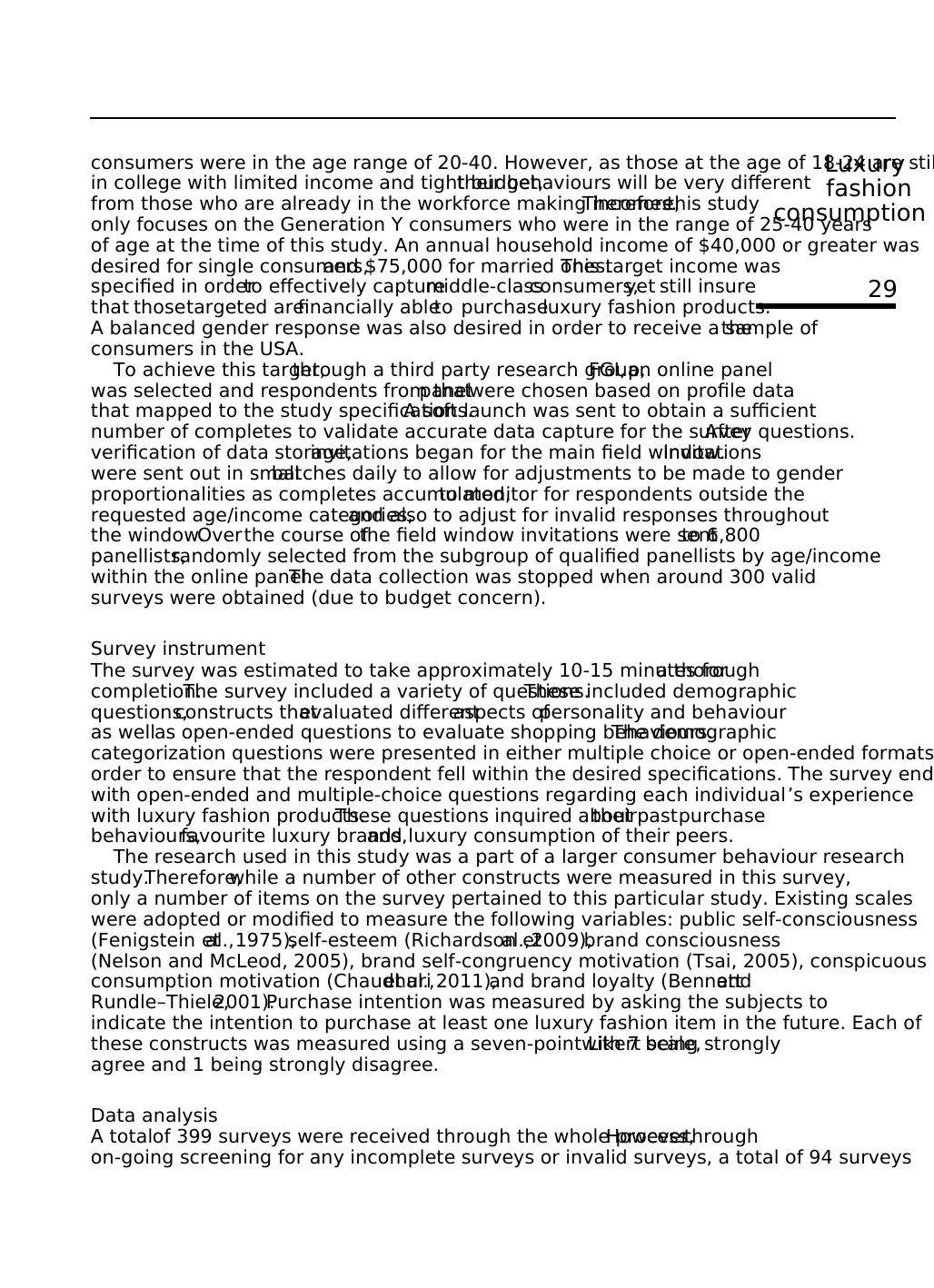
consumers were in the age range of 20-40. However, as those at the age of 18-24 are stil
in college with limited income and tight budget,their behaviours will be very different
from those who are already in the workforce making incomes.Therefore,this study
only focuses on the Generation Y consumers who were in the range of 25-40 years
of age at the time of this study. An annual household income of $40,000 or greater was
desired for single consumers,and $75,000 for married ones.This target income was
specified in orderto effectively capturemiddle-classconsumers,yet still insure
that thosetargeted arefinancially ableto purchaseluxury fashion products.
A balanced gender response was also desired in order to receive a sample ofthe
consumers in the USA.
To achieve this target,through a third party research group,FGI, an online panel
was selected and respondents from thatpanelwere chosen based on profile data
that mapped to the study specifications.A soft launch was sent to obtain a sufficient
number of completes to validate accurate data capture for the survey questions.After
verification of data storage,invitations began for the main field window.Invitations
were sent out in smallbatches daily to allow for adjustments to be made to gender
proportionalities as completes accumulated,to monitor for respondents outside the
requested age/income categories,and also to adjust for invalid responses throughout
the window.Overthe course ofthe field window invitations were sentto 6,800
panellists,randomly selected from the subgroup of qualified panellists by age/income
within the online panel.The data collection was stopped when around 300 valid
surveys were obtained (due to budget concern).
Survey instrument
The survey was estimated to take approximately 10-15 minutes fora thorough
completion.The survey included a variety of questions.These included demographic
questions,constructs thatevaluated differentaspects ofpersonality and behaviour
as wellas open-ended questions to evaluate shopping behaviours.The demographic
categorization questions were presented in either multiple choice or open-ended formats
order to ensure that the respondent fell within the desired specifications. The survey end
with open-ended and multiple-choice questions regarding each individual’s experience
with luxury fashion products.These questions inquired abouttheirpastpurchase
behaviours,favourite luxury brands,and luxury consumption of their peers.
The research used in this study was a part of a larger consumer behaviour research
study.Therefore,while a number of other constructs were measured in this survey,
only a number of items on the survey pertained to this particular study. Existing scales
were adopted or modified to measure the following variables: public self-consciousness
(Fenigstein etal.,1975),self-esteem (Richardson etal.,2009),brand consciousness
(Nelson and McLeod, 2005), brand self-congruency motivation (Tsai, 2005), conspicuous
consumption motivation (Chaudhuriet al.,2011),and brand loyalty (Bennettand
Rundle–Thiele,2001).Purchase intention was measured by asking the subjects to
indicate the intention to purchase at least one luxury fashion item in the future. Each of
these constructs was measured using a seven-point Likert scale,with 7 being strongly
agree and 1 being strongly disagree.
Data analysis
A totalof 399 surveys were received through the whole process.However,through
on-going screening for any incomplete surveys or invalid surveys, a total of 94 surveys
29
Luxury
fashion
consumption
in college with limited income and tight budget,their behaviours will be very different
from those who are already in the workforce making incomes.Therefore,this study
only focuses on the Generation Y consumers who were in the range of 25-40 years
of age at the time of this study. An annual household income of $40,000 or greater was
desired for single consumers,and $75,000 for married ones.This target income was
specified in orderto effectively capturemiddle-classconsumers,yet still insure
that thosetargeted arefinancially ableto purchaseluxury fashion products.
A balanced gender response was also desired in order to receive a sample ofthe
consumers in the USA.
To achieve this target,through a third party research group,FGI, an online panel
was selected and respondents from thatpanelwere chosen based on profile data
that mapped to the study specifications.A soft launch was sent to obtain a sufficient
number of completes to validate accurate data capture for the survey questions.After
verification of data storage,invitations began for the main field window.Invitations
were sent out in smallbatches daily to allow for adjustments to be made to gender
proportionalities as completes accumulated,to monitor for respondents outside the
requested age/income categories,and also to adjust for invalid responses throughout
the window.Overthe course ofthe field window invitations were sentto 6,800
panellists,randomly selected from the subgroup of qualified panellists by age/income
within the online panel.The data collection was stopped when around 300 valid
surveys were obtained (due to budget concern).
Survey instrument
The survey was estimated to take approximately 10-15 minutes fora thorough
completion.The survey included a variety of questions.These included demographic
questions,constructs thatevaluated differentaspects ofpersonality and behaviour
as wellas open-ended questions to evaluate shopping behaviours.The demographic
categorization questions were presented in either multiple choice or open-ended formats
order to ensure that the respondent fell within the desired specifications. The survey end
with open-ended and multiple-choice questions regarding each individual’s experience
with luxury fashion products.These questions inquired abouttheirpastpurchase
behaviours,favourite luxury brands,and luxury consumption of their peers.
The research used in this study was a part of a larger consumer behaviour research
study.Therefore,while a number of other constructs were measured in this survey,
only a number of items on the survey pertained to this particular study. Existing scales
were adopted or modified to measure the following variables: public self-consciousness
(Fenigstein etal.,1975),self-esteem (Richardson etal.,2009),brand consciousness
(Nelson and McLeod, 2005), brand self-congruency motivation (Tsai, 2005), conspicuous
consumption motivation (Chaudhuriet al.,2011),and brand loyalty (Bennettand
Rundle–Thiele,2001).Purchase intention was measured by asking the subjects to
indicate the intention to purchase at least one luxury fashion item in the future. Each of
these constructs was measured using a seven-point Likert scale,with 7 being strongly
agree and 1 being strongly disagree.
Data analysis
A totalof 399 surveys were received through the whole process.However,through
on-going screening for any incomplete surveys or invalid surveys, a total of 94 surveys
29
Luxury
fashion
consumption
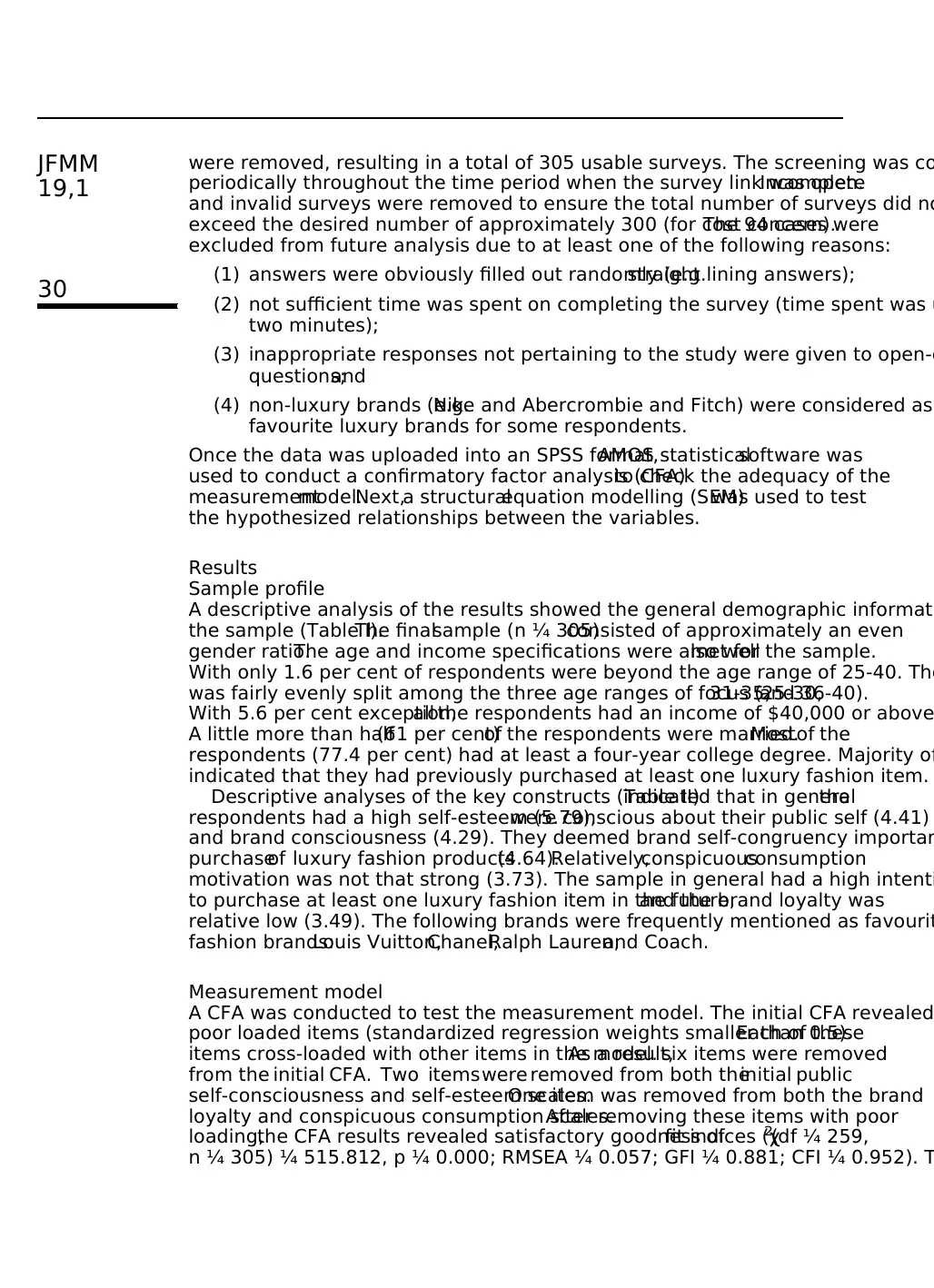
were removed, resulting in a total of 305 usable surveys. The screening was co
periodically throughout the time period when the survey link was open.Incomplete
and invalid surveys were removed to ensure the total number of surveys did no
exceed the desired number of approximately 300 (for cost concern).The 94 cases were
excluded from future analysis due to at least one of the following reasons:
(1) answers were obviously filled out randomly (e.g.straight lining answers);
(2) not sufficient time was spent on completing the survey (time spent was u
two minutes);
(3) inappropriate responses not pertaining to the study were given to open-e
questions;and
(4) non-luxury brands (e.g.Nike and Abercrombie and Fitch) were considered as
favourite luxury brands for some respondents.
Once the data was uploaded into an SPSS format,AMOS statisticalsoftware was
used to conduct a confirmatory factor analysis (CFA)to check the adequacy of the
measurementmodel.Next,a structuralequation modelling (SEM)was used to test
the hypothesized relationships between the variables.
Results
Sample profile
A descriptive analysis of the results showed the general demographic informati
the sample (Table I).The finalsample (n ¼ 305)consisted of approximately an even
gender ratio.The age and income specifications were also wellmet for the sample.
With only 1.6 per cent of respondents were beyond the age range of 25-40. The
was fairly evenly split among the three age ranges of focus (25-30,31-35,and 36-40).
With 5.6 per cent exception,all the respondents had an income of $40,000 or above
A little more than half(61 per cent)of the respondents were married.Mostof the
respondents (77.4 per cent) had at least a four-year college degree. Majority of
indicated that they had previously purchased at least one luxury fashion item.
Descriptive analyses of the key constructs (Table II)indicated that in generalthe
respondents had a high self-esteem (5.79),were conscious about their public self (4.41)
and brand consciousness (4.29). They deemed brand self-congruency importan
purchaseof luxury fashion products(4.64).Relatively,conspicuousconsumption
motivation was not that strong (3.73). The sample in general had a high intenti
to purchase at least one luxury fashion item in the future,and the brand loyalty was
relative low (3.49). The following brands were frequently mentioned as favourit
fashion brands:Louis Vuitton,Chanel,Ralph Lauren,and Coach.
Measurement model
A CFA was conducted to test the measurement model. The initial CFA revealed
poor loaded items (standardized regression weights smaller than 0.5).Each of these
items cross-loaded with other items in the model.As a result,six items were removed
from the initial CFA. Two itemswere removed from both theinitial public
self-consciousness and self-esteem scales.One item was removed from both the brand
loyalty and conspicuous consumption scales.After removing these items with poor
loading,the CFA results revealed satisfactory goodness offit indices (χ2(df ¼ 259,
n ¼ 305) ¼ 515.812, p ¼ 0.000; RMSEA ¼ 0.057; GFI ¼ 0.881; CFI ¼ 0.952). T
30
JFMM
19,1
periodically throughout the time period when the survey link was open.Incomplete
and invalid surveys were removed to ensure the total number of surveys did no
exceed the desired number of approximately 300 (for cost concern).The 94 cases were
excluded from future analysis due to at least one of the following reasons:
(1) answers were obviously filled out randomly (e.g.straight lining answers);
(2) not sufficient time was spent on completing the survey (time spent was u
two minutes);
(3) inappropriate responses not pertaining to the study were given to open-e
questions;and
(4) non-luxury brands (e.g.Nike and Abercrombie and Fitch) were considered as
favourite luxury brands for some respondents.
Once the data was uploaded into an SPSS format,AMOS statisticalsoftware was
used to conduct a confirmatory factor analysis (CFA)to check the adequacy of the
measurementmodel.Next,a structuralequation modelling (SEM)was used to test
the hypothesized relationships between the variables.
Results
Sample profile
A descriptive analysis of the results showed the general demographic informati
the sample (Table I).The finalsample (n ¼ 305)consisted of approximately an even
gender ratio.The age and income specifications were also wellmet for the sample.
With only 1.6 per cent of respondents were beyond the age range of 25-40. The
was fairly evenly split among the three age ranges of focus (25-30,31-35,and 36-40).
With 5.6 per cent exception,all the respondents had an income of $40,000 or above
A little more than half(61 per cent)of the respondents were married.Mostof the
respondents (77.4 per cent) had at least a four-year college degree. Majority of
indicated that they had previously purchased at least one luxury fashion item.
Descriptive analyses of the key constructs (Table II)indicated that in generalthe
respondents had a high self-esteem (5.79),were conscious about their public self (4.41)
and brand consciousness (4.29). They deemed brand self-congruency importan
purchaseof luxury fashion products(4.64).Relatively,conspicuousconsumption
motivation was not that strong (3.73). The sample in general had a high intenti
to purchase at least one luxury fashion item in the future,and the brand loyalty was
relative low (3.49). The following brands were frequently mentioned as favourit
fashion brands:Louis Vuitton,Chanel,Ralph Lauren,and Coach.
Measurement model
A CFA was conducted to test the measurement model. The initial CFA revealed
poor loaded items (standardized regression weights smaller than 0.5).Each of these
items cross-loaded with other items in the model.As a result,six items were removed
from the initial CFA. Two itemswere removed from both theinitial public
self-consciousness and self-esteem scales.One item was removed from both the brand
loyalty and conspicuous consumption scales.After removing these items with poor
loading,the CFA results revealed satisfactory goodness offit indices (χ2(df ¼ 259,
n ¼ 305) ¼ 515.812, p ¼ 0.000; RMSEA ¼ 0.057; GFI ¼ 0.881; CFI ¼ 0.952). T
30
JFMM
19,1
⊘ This is a preview!⊘
Do you want full access?
Subscribe today to unlock all pages.

Trusted by 1+ million students worldwide
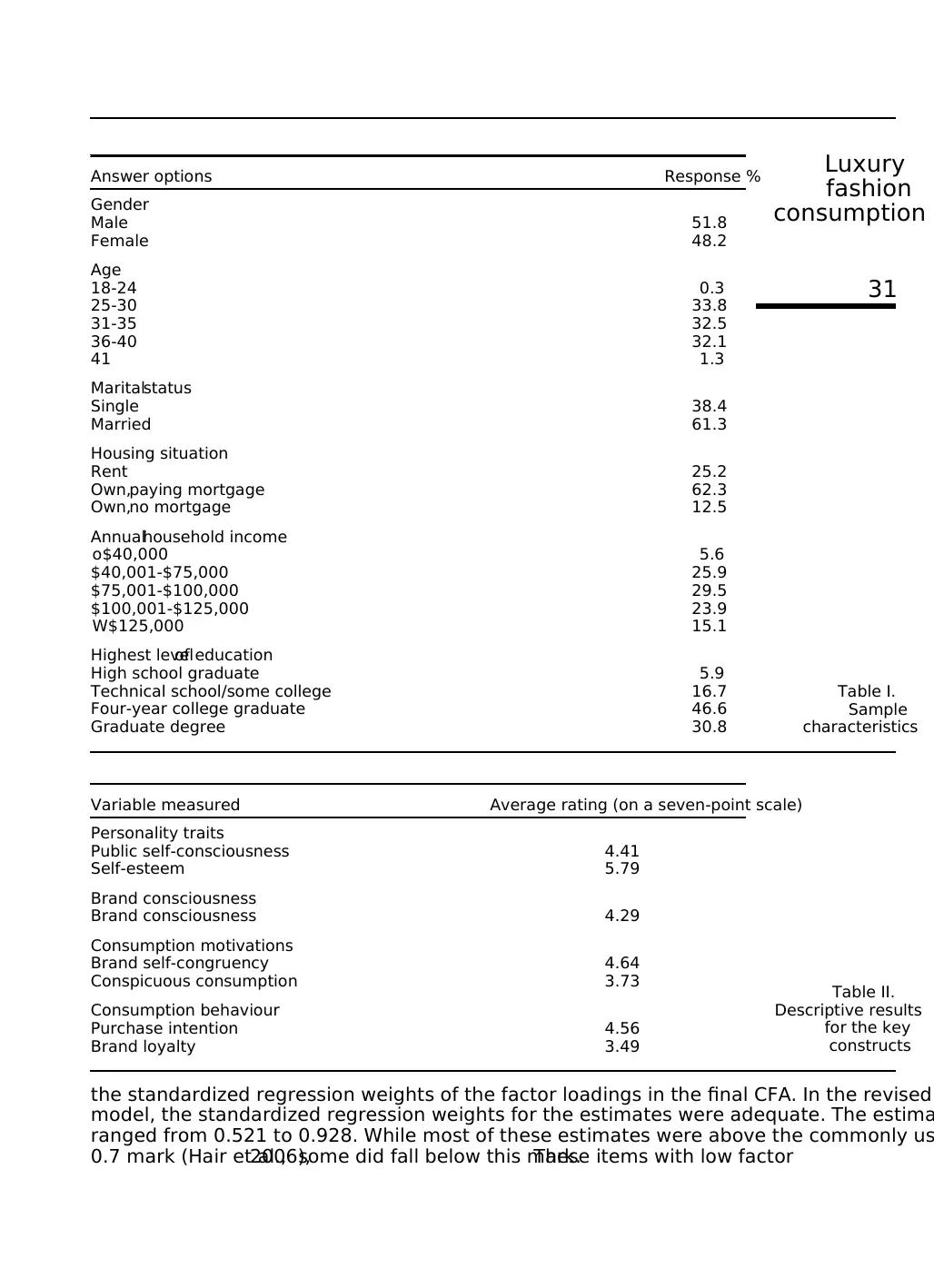
the standardized regression weights of the factor loadings in the final CFA. In the revised
model, the standardized regression weights for the estimates were adequate. The estima
ranged from 0.521 to 0.928. While most of these estimates were above the commonly us
0.7 mark (Hair et al.,2006),some did fall below this mark.These items with low factor
Answer options Response %
Gender
Male 51.8
Female 48.2
Age
18-24 0.3
25-30 33.8
31-35 32.5
36-40 32.1
41 1.3
Maritalstatus
Single 38.4
Married 61.3
Housing situation
Rent 25.2
Own,paying mortgage 62.3
Own,no mortgage 12.5
Annualhousehold income
o$40,000 5.6
$40,001-$75,000 25.9
$75,001-$100,000 29.5
$100,001-$125,000 23.9
W$125,000 15.1
Highest levelof education
High school graduate 5.9
Technical school/some college 16.7
Four-year college graduate 46.6
Graduate degree 30.8
Table I.
Sample
characteristics
Variable measured Average rating (on a seven-point scale)
Personality traits
Public self-consciousness 4.41
Self-esteem 5.79
Brand consciousness
Brand consciousness 4.29
Consumption motivations
Brand self-congruency 4.64
Conspicuous consumption 3.73
Consumption behaviour
Purchase intention 4.56
Brand loyalty 3.49
Table II.
Descriptive results
for the key
constructs
31
Luxury
fashion
consumption
model, the standardized regression weights for the estimates were adequate. The estima
ranged from 0.521 to 0.928. While most of these estimates were above the commonly us
0.7 mark (Hair et al.,2006),some did fall below this mark.These items with low factor
Answer options Response %
Gender
Male 51.8
Female 48.2
Age
18-24 0.3
25-30 33.8
31-35 32.5
36-40 32.1
41 1.3
Maritalstatus
Single 38.4
Married 61.3
Housing situation
Rent 25.2
Own,paying mortgage 62.3
Own,no mortgage 12.5
Annualhousehold income
o$40,000 5.6
$40,001-$75,000 25.9
$75,001-$100,000 29.5
$100,001-$125,000 23.9
W$125,000 15.1
Highest levelof education
High school graduate 5.9
Technical school/some college 16.7
Four-year college graduate 46.6
Graduate degree 30.8
Table I.
Sample
characteristics
Variable measured Average rating (on a seven-point scale)
Personality traits
Public self-consciousness 4.41
Self-esteem 5.79
Brand consciousness
Brand consciousness 4.29
Consumption motivations
Brand self-congruency 4.64
Conspicuous consumption 3.73
Consumption behaviour
Purchase intention 4.56
Brand loyalty 3.49
Table II.
Descriptive results
for the key
constructs
31
Luxury
fashion
consumption
Paraphrase This Document
Need a fresh take? Get an instant paraphrase of this document with our AI Paraphraser
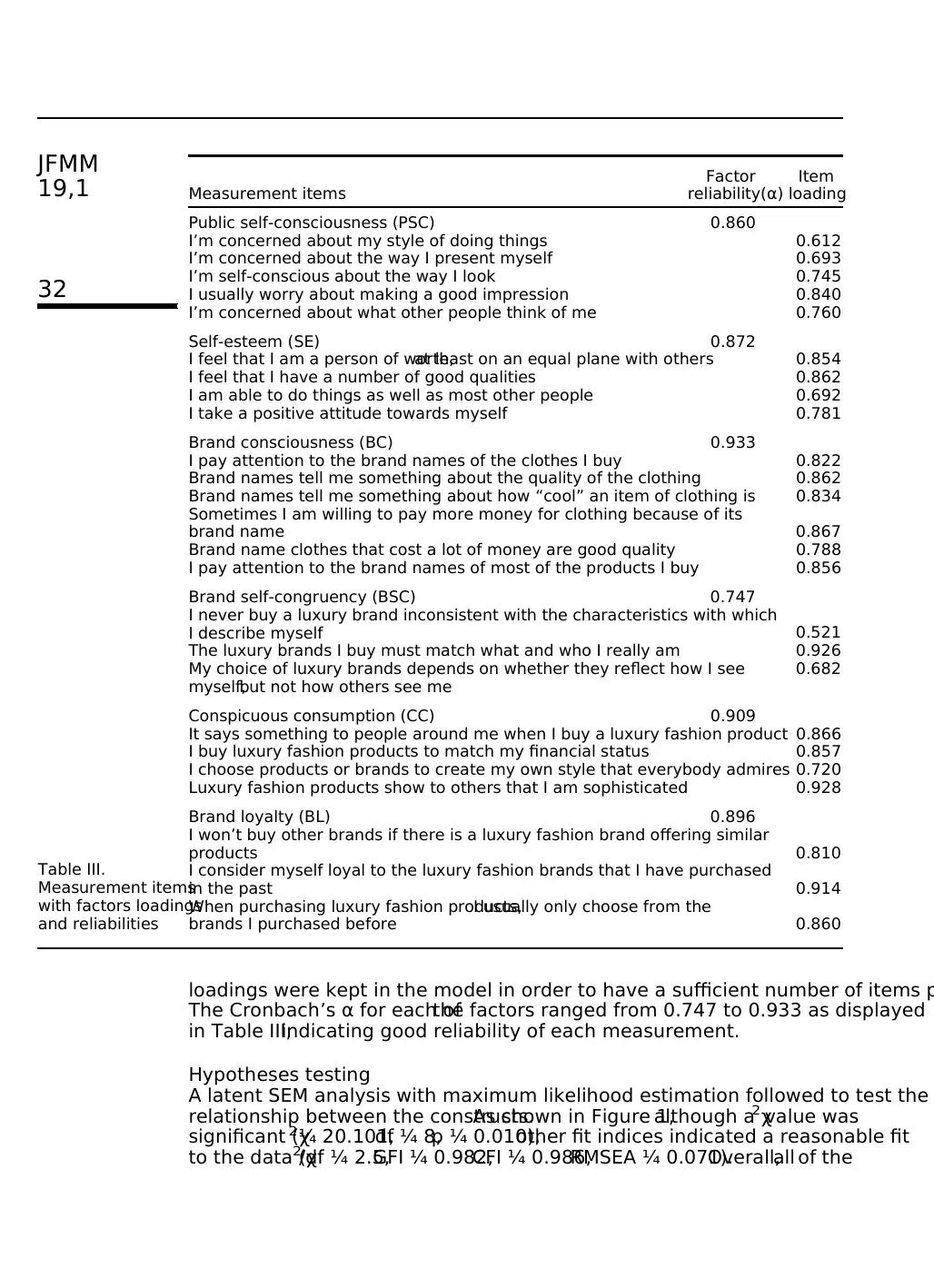
loadings were kept in the model in order to have a sufficient number of items p
The Cronbach’s α for each ofthe factors ranged from 0.747 to 0.933 as displayed
in Table III,indicating good reliability of each measurement.
Hypotheses testing
A latent SEM analysis with maximum likelihood estimation followed to test the
relationship between the constructs.As shown in Figure 1,although a χ2 value was
significant (χ2¼ 20.101,df ¼ 8,p ¼ 0.010),other fit indices indicated a reasonable fit
to the data (χ2/df ¼ 2.5,GFI ¼ 0.982,CFI ¼ 0.986,RMSEA ¼ 0.071).Overall,all of the
Measurement items
Factor
reliability(α)
Item
loading
Public self-consciousness (PSC) 0.860
I’m concerned about my style of doing things 0.612
I’m concerned about the way I present myself 0.693
I’m self-conscious about the way I look 0.745
I usually worry about making a good impression 0.840
I’m concerned about what other people think of me 0.760
Self-esteem (SE) 0.872
I feel that I am a person of worth,at least on an equal plane with others 0.854
I feel that I have a number of good qualities 0.862
I am able to do things as well as most other people 0.692
I take a positive attitude towards myself 0.781
Brand consciousness (BC) 0.933
I pay attention to the brand names of the clothes I buy 0.822
Brand names tell me something about the quality of the clothing 0.862
Brand names tell me something about how “cool” an item of clothing is 0.834
Sometimes I am willing to pay more money for clothing because of its
brand name 0.867
Brand name clothes that cost a lot of money are good quality 0.788
I pay attention to the brand names of most of the products I buy 0.856
Brand self-congruency (BSC) 0.747
I never buy a luxury brand inconsistent with the characteristics with which
I describe myself 0.521
The luxury brands I buy must match what and who I really am 0.926
My choice of luxury brands depends on whether they reflect how I see
myself,but not how others see me
0.682
Conspicuous consumption (CC) 0.909
It says something to people around me when I buy a luxury fashion product 0.866
I buy luxury fashion products to match my financial status 0.857
I choose products or brands to create my own style that everybody admires 0.720
Luxury fashion products show to others that I am sophisticated 0.928
Brand loyalty (BL) 0.896
I won’t buy other brands if there is a luxury fashion brand offering similar
products 0.810
I consider myself loyal to the luxury fashion brands that I have purchased
in the past 0.914
When purchasing luxury fashion products,I usually only choose from the
brands I purchased before 0.860
Table III.
Measurement items
with factors loadings
and reliabilities
32
JFMM
19,1
The Cronbach’s α for each ofthe factors ranged from 0.747 to 0.933 as displayed
in Table III,indicating good reliability of each measurement.
Hypotheses testing
A latent SEM analysis with maximum likelihood estimation followed to test the
relationship between the constructs.As shown in Figure 1,although a χ2 value was
significant (χ2¼ 20.101,df ¼ 8,p ¼ 0.010),other fit indices indicated a reasonable fit
to the data (χ2/df ¼ 2.5,GFI ¼ 0.982,CFI ¼ 0.986,RMSEA ¼ 0.071).Overall,all of the
Measurement items
Factor
reliability(α)
Item
loading
Public self-consciousness (PSC) 0.860
I’m concerned about my style of doing things 0.612
I’m concerned about the way I present myself 0.693
I’m self-conscious about the way I look 0.745
I usually worry about making a good impression 0.840
I’m concerned about what other people think of me 0.760
Self-esteem (SE) 0.872
I feel that I am a person of worth,at least on an equal plane with others 0.854
I feel that I have a number of good qualities 0.862
I am able to do things as well as most other people 0.692
I take a positive attitude towards myself 0.781
Brand consciousness (BC) 0.933
I pay attention to the brand names of the clothes I buy 0.822
Brand names tell me something about the quality of the clothing 0.862
Brand names tell me something about how “cool” an item of clothing is 0.834
Sometimes I am willing to pay more money for clothing because of its
brand name 0.867
Brand name clothes that cost a lot of money are good quality 0.788
I pay attention to the brand names of most of the products I buy 0.856
Brand self-congruency (BSC) 0.747
I never buy a luxury brand inconsistent with the characteristics with which
I describe myself 0.521
The luxury brands I buy must match what and who I really am 0.926
My choice of luxury brands depends on whether they reflect how I see
myself,but not how others see me
0.682
Conspicuous consumption (CC) 0.909
It says something to people around me when I buy a luxury fashion product 0.866
I buy luxury fashion products to match my financial status 0.857
I choose products or brands to create my own style that everybody admires 0.720
Luxury fashion products show to others that I am sophisticated 0.928
Brand loyalty (BL) 0.896
I won’t buy other brands if there is a luxury fashion brand offering similar
products 0.810
I consider myself loyal to the luxury fashion brands that I have purchased
in the past 0.914
When purchasing luxury fashion products,I usually only choose from the
brands I purchased before 0.860
Table III.
Measurement items
with factors loadings
and reliabilities
32
JFMM
19,1
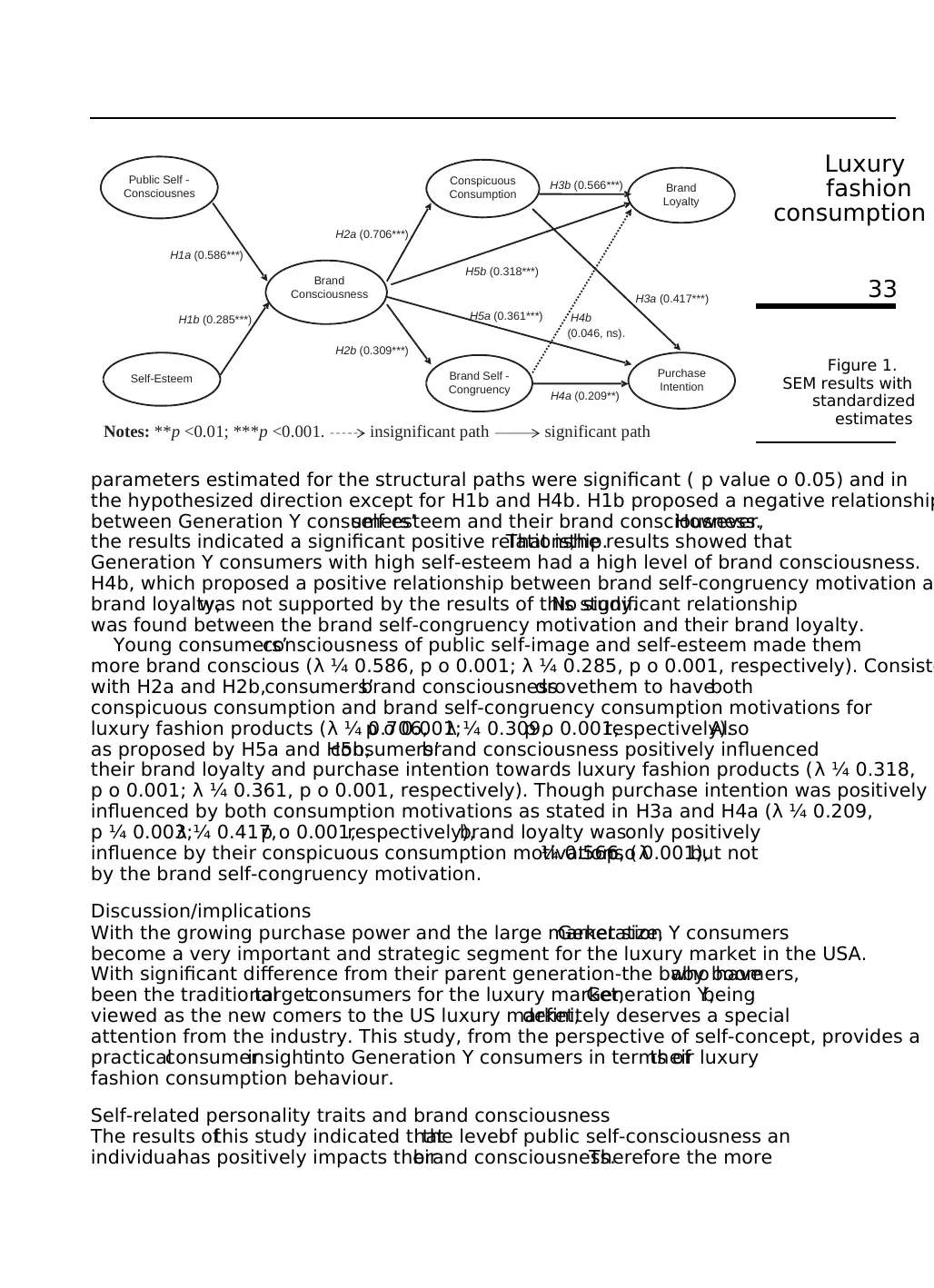
parameters estimated for the structural paths were significant ( p value o 0.05) and in
the hypothesized direction except for H1b and H4b. H1b proposed a negative relationship
between Generation Y consumers’self-esteem and their brand consciousness.However,
the results indicated a significant positive relationship.That is,the results showed that
Generation Y consumers with high self-esteem had a high level of brand consciousness.
H4b, which proposed a positive relationship between brand self-congruency motivation a
brand loyalty,was not supported by the results of this study.No significant relationship
was found between the brand self-congruency motivation and their brand loyalty.
Young consumers’consciousness of public self-image and self-esteem made them
more brand conscious (λ ¼ 0.586, p o 0.001; λ ¼ 0.285, p o 0.001, respectively). Consiste
with H2a and H2b,consumers’brand consciousnessdrovethem to haveboth
conspicuous consumption and brand self-congruency consumption motivations for
luxury fashion products (λ ¼ 0.706,p o 0.001;λ ¼ 0.309,p o 0.001,respectively).Also
as proposed by H5a and H5b,consumers’brand consciousness positively influenced
their brand loyalty and purchase intention towards luxury fashion products (λ ¼ 0.318,
p o 0.001; λ ¼ 0.361, p o 0.001, respectively). Though purchase intention was positively
influenced by both consumption motivations as stated in H3a and H4a (λ ¼ 0.209,
p ¼ 0.003;λ ¼ 0.417,p o 0.001,respectively),brand loyalty wasonly positively
influence by their conspicuous consumption motivations (λ¼ 0.566,p o 0.001),but not
by the brand self-congruency motivation.
Discussion/implications
With the growing purchase power and the large market size,Generation Y consumers
become a very important and strategic segment for the luxury market in the USA.
With significant difference from their parent generation-the baby boomers,who have
been the traditionaltargetconsumers for the luxury market,Generation Y,being
viewed as the new comers to the US luxury market,definitely deserves a special
attention from the industry. This study, from the perspective of self-concept, provides a
practicalconsumerinsightinto Generation Y consumers in terms oftheir luxury
fashion consumption behaviour.
Self-related personality traits and brand consciousness
The results ofthis study indicated thatthe levelof public self-consciousness an
individualhas positively impacts theirbrand consciousness.Therefore the more
Self-Esteem
Public Self -
Consciousnes
Brand
Consciousness
Conspicuous
Consumption Brand
Loyalty
Brand Self -
Congruency
Purchase
Intention
H4b
(0.046, ns).
H1a (0.586***)
H1b (0.285***)
H2a (0.706***)
H5a (0.361***)
H2b (0.309***)
H5b (0.318***)
H3a (0.417***)
H3b (0.566***)
H4a (0.209**)
Notes: **p <0.01; ***p <0.001. insignificant path significant path
Figure 1.
SEM results with
standardized
estimates
33
Luxury
fashion
consumption
the hypothesized direction except for H1b and H4b. H1b proposed a negative relationship
between Generation Y consumers’self-esteem and their brand consciousness.However,
the results indicated a significant positive relationship.That is,the results showed that
Generation Y consumers with high self-esteem had a high level of brand consciousness.
H4b, which proposed a positive relationship between brand self-congruency motivation a
brand loyalty,was not supported by the results of this study.No significant relationship
was found between the brand self-congruency motivation and their brand loyalty.
Young consumers’consciousness of public self-image and self-esteem made them
more brand conscious (λ ¼ 0.586, p o 0.001; λ ¼ 0.285, p o 0.001, respectively). Consiste
with H2a and H2b,consumers’brand consciousnessdrovethem to haveboth
conspicuous consumption and brand self-congruency consumption motivations for
luxury fashion products (λ ¼ 0.706,p o 0.001;λ ¼ 0.309,p o 0.001,respectively).Also
as proposed by H5a and H5b,consumers’brand consciousness positively influenced
their brand loyalty and purchase intention towards luxury fashion products (λ ¼ 0.318,
p o 0.001; λ ¼ 0.361, p o 0.001, respectively). Though purchase intention was positively
influenced by both consumption motivations as stated in H3a and H4a (λ ¼ 0.209,
p ¼ 0.003;λ ¼ 0.417,p o 0.001,respectively),brand loyalty wasonly positively
influence by their conspicuous consumption motivations (λ¼ 0.566,p o 0.001),but not
by the brand self-congruency motivation.
Discussion/implications
With the growing purchase power and the large market size,Generation Y consumers
become a very important and strategic segment for the luxury market in the USA.
With significant difference from their parent generation-the baby boomers,who have
been the traditionaltargetconsumers for the luxury market,Generation Y,being
viewed as the new comers to the US luxury market,definitely deserves a special
attention from the industry. This study, from the perspective of self-concept, provides a
practicalconsumerinsightinto Generation Y consumers in terms oftheir luxury
fashion consumption behaviour.
Self-related personality traits and brand consciousness
The results ofthis study indicated thatthe levelof public self-consciousness an
individualhas positively impacts theirbrand consciousness.Therefore the more
Self-Esteem
Public Self -
Consciousnes
Brand
Consciousness
Conspicuous
Consumption Brand
Loyalty
Brand Self -
Congruency
Purchase
Intention
H4b
(0.046, ns).
H1a (0.586***)
H1b (0.285***)
H2a (0.706***)
H5a (0.361***)
H2b (0.309***)
H5b (0.318***)
H3a (0.417***)
H3b (0.566***)
H4a (0.209**)
Notes: **p <0.01; ***p <0.001. insignificant path significant path
Figure 1.
SEM results with
standardized
estimates
33
Luxury
fashion
consumption
⊘ This is a preview!⊘
Do you want full access?
Subscribe today to unlock all pages.

Trusted by 1+ million students worldwide
1 out of 20
Related Documents
Your All-in-One AI-Powered Toolkit for Academic Success.
+13062052269
info@desklib.com
Available 24*7 on WhatsApp / Email
![[object Object]](/_next/static/media/star-bottom.7253800d.svg)
Unlock your academic potential
Copyright © 2020–2025 A2Z Services. All Rights Reserved. Developed and managed by ZUCOL.





